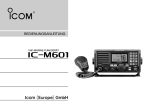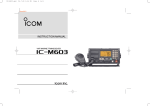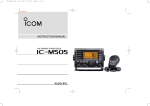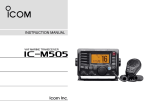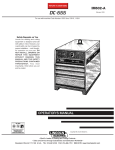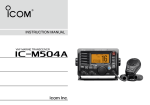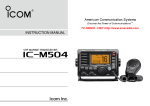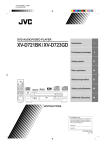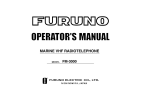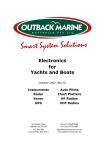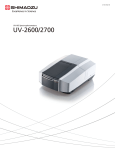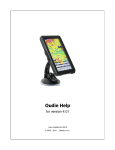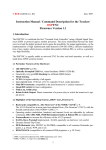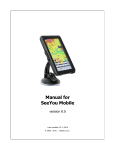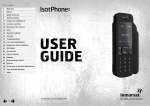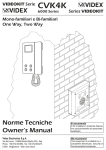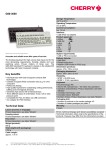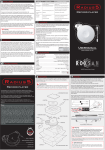Download INSTRUCTION MANUAL
Transcript
INSTRUCTION MANUAL
VHF MARINE TRANSCEIVER
iM602
This device complies with Part 15 of the FCC rules. Operation is subject to the following two conditions: (1) This device may not cause
harmful interference, and (2) this device must accept any interference
received, including interference that may cause undesired operation.
FOREWORD
IMPORTANT
Thank you for purchasing this Icom product. The ICM602 VHF MARINE TRANSCEIVER is designed and built
with Icom’s state of the art technology and craftsmanship. With proper care, this product should provide you
with years of trouble-free operation.
READ THIS INSTRUCTION MANUAL
CAREFULLY before attempting to operate the trans-
We want to take a couple of moments of your time to
thank you for making the IC-M602 your radio of choice,
and hope you agree with Icom’s philosophy of “technology first.” Many hours of research and development
went into the design of your IC-M602.
D FEATURES
❍ Standard 4×8″ flush mount design
❍ Built-in DSC meets ITU Class D requirement
❍ Rugged waterproof construction
❍ Large LCD with dot matrix characters
❍ Superior receiver performance
❍ Optional COMMANDMICTM
(2 systems are connectable)
i
ceiver.
SAVE THIS INSTRUCTION MANUAL. This
manual contains important safety and operating instructions for the IC-M602.
CLEAN THE TRANSCEIVER AND MICROPHONE
THOROUGHLY WITH FRESH WATER after exposure to
water including salt water, otherwise, the keys and
switches may become inoperable due to salt crystallization.
Icom, Icom Inc. and the
logo are registered trademarks
of Icom Incorporated (Japan) in the United states, the United
Kingdom, Germany, France, Spain, Russia and/or other countries.
IN CASE OF EMERGENCY
NOTE
If your vessel requires assistance, contact other vessels and
the Coast Guard by sending a distress call on Ch 16.
A WARNING STICKER is supplied with the transceiver.
To comply with FCC regulations, this sticker must be affixed in
such a location as to be readily seen from the operating controls of the radio as in the diagram below. Make sure the chosen location is clean and dry before applying the sticker. (p. 48)
USING CHANNEL 16
DISTRESS CALL PROCEDURE
1. “MAYDAY MAYDAY MAYDAY.”
2. “THIS IS ...............” (name of vessel)
3. Your call sign or other indication of the vessel (AND 9digit DSC ID if you have one).
4. “LOCATED AT ...............” (your position)
5. The nature of the distress and assistance required.
6. Any other information which might facilitate the rescue.
EXAMPLE
WARNING
STICKER
Or, transmit your distress call using digital selective calling on
Ch 70.
USING DIGITAL SELECTIVE CALLING (Ch 70)
DISTRESS CALL PROCEDURE
1. While lifting up the switch cover, push and hold
[DISTRESS] for 5 sec. until you hear 5 short beeps
change to one long beep.
2. Wait for an acknowledgment from a coast station.
• Channel 16 is automatically selected.
3. Push and hold [PTT], then transmit the appropriate
information as at above.
ii
RADIO OPERATOR WARNING
Icom requires the radio operator to meet the
FCC Requirements for Radio Frequency Exposure. An omnidirectional antenna with gain not
greater than 9 dBi must be mounted a minimum
W ARN ING of 5 meters (measured from the lowest point of
the antenna) vertically above the main deck and all possible
personnel. This is the minimum safe separation distance estimated to meet all RF exposure compliance requirements. This
5 meter distance is based on the FCC Safe Maximum Permissible Exposure (MPE) distance of 3 meters added to the
height of an adult (2 meters) and is appropriate for all vessels.
FAILURE TO OBSERVE THESE LIMITS MAY ALLOW
THOSE WITHIN THE MPE RADIUS TO EXPERIENCE RF
RADIATION ABSORPTION WHICH EXCEEDS THE FCC
MAXIMUM PERMISSIBLE EXPOSURE (MPE) LIMIT.
IT IS THE RESPONSIBILITY OF THE RADIO OPERATOR
TO ENSURE THAT THE MAXIMUM PERMISSIBLE EXPOSURE LIMITS ARE OBSERVED AT ALL TIMES DURING
RADIO TRANSMISSION. THE RADIO OPERATOR IS TO
ENSURE THAT NO BYSTANDERS COME WITHIN THE
RADIUS OF THE MAXIMUM PERMISSIBLE EXPOSURE
LIMITS.
For watercraft without suitable structures, the antenna must
be mounted so as to maintain a minimum of 1 meter vertically
between the antenna, (measured from the lowest point of the
antenna), to the heads of all persons AND all persons must
stay outside of the 3 meter MPE radius.
Determining MPE Radius
THE MAXIMUM PERMISSIBLE EXPOSURE (MPE) RADIUS HAS BEEN ESTIMATED TO BE A RADIUS OF
ABOUT 3M PER OET BULLETIN 65 OF THE FCC.
THIS ESTIMATE IS MADE ASSUMING THE MAXIMUM
POWER OF THE RADIO AND ANTENNAS WITH A MAXIMUM GAIN OF 9dBi ARE USED FOR A SHIP MOUNTED
SYSTEM.
Do not transmit with radio and antenna when persons are
within the MPE radius of the antenna, unless such persons
(such as driver or radio operator) are shielded from antenna
field by a grounded metallic barrier. The MPE Radius is the
minimum distance from the antenna axis that person should
maintain in order to avoid RF exposure higher than the allowable MPE level set by FCC.
iii
TABLE OF CONTENTS
■ Position and time programming .... 18
■ Position indication ......................... 19
■ Distress call .................................. 20
■ Transmitting DSC calls ................. 22
■ Setting the distress information .... 30
■ DSC individual ID ......................... 31
■ Receiving DSC calls ..................... 34
■ DSC set mode .............................. 36
■ Received messages ..................... 38
FOREWORD ............................................. i
IMPORTANT .............................................. i
IN CASE OF EMERGENCY ...................... ii
NOTE ........................................................ ii
RADIO OPERATOR WARNING ............... iii
TABLE OF CONTENTS ........................... iv
PRECAUTION .......................................... v
1
2
OPERATING RULES .................. 1
PANEL DESCRIPTION .......... 2 – 7
■ Panel description ............................ 2
■ Function display .............................. 6
■ Microphone (HM-136) ..................... 7
3
DUALWATCH/TRI-WATCH ... 14–15
■ Description .................................... 14
■ Operation ...................................... 15
5
SCAN OPERATIONS ......... 16 – 17
■ Scan types .................................... 16
■ Setting tag channels ..................... 17
■ Starting a scan .............................. 17
6
DSC OPERATION .............. 18 – 39
■ MMSI code programming ............. 18
OTHER FUNCTIONS .......... 40–46
■ Intercom operation ........................ 40
■ Hailer operation ............................ 41
■ Automatic fog horn ........................ 42
■ Microphone lock function .............. 43
BASIC OPERATION ............ 8 – 13
■ Channel selection ........................... 8
■ Receiving and transmitting ........... 10
■ Call channel programming ............ 11
■ Channel comments ....................... 11
■ Optional voice scrambler operation ... 13
4
7
8
SET MODE ........................ 44 – 47
■ Set mode programming ................ 44
■ Set mode items ............................. 45
9
CONNECTIONS AND
MAINTENANCE ................. 48 – 53
■ Supplied accessories .................... 48
■ Antenna ........................................ 48
■ Fuse replacement ......................... 48
■ Cleaning ....................................... 48
■ Connections .................................. 49
■ Mounting the transceiver .............. 50
■ Optional unit installation ............... 52
■ Dimensions ................................... 53
11 CHANNEL LIST ........................ 55
12 SPECIFICATIONS AND
OPTIONS ........................... 56 – 57
■ Specifications ............................... 56
■ Options ......................................... 57
13 HM-127 REMOTE-CONTROL
MICROPHONE ................... 58 – 70
■ Panel description .......................... 58
■ Function display ............................ 60
■ HM-127 supplied accessories ...... 61
■ Installation .................................... 62
■ Channel selection ......................... 64
■ Receiving and transmitting ........... 65
■ RF attenuator function .................. 65
■ Lock functions ............................... 66
■ Display backlighting ...................... 66
■ Monitor function ............................ 66
■ Call channel programming ............ 67
■ Optional voice scrambler operation ... 67
■ Starting a scan .............................. 68
■ Setting tag channels ..................... 68
■ Dualwatch/Tri-watch operation ..... 68
■ Set mode programming ................ 69
■ Intercom operation ........................ 70
■ Channel comments ....................... 70
1
2
3
4
5
6
7
8
9
10
11
12
13
TEMPLATE
10 TROUBLESHOOTING .............. 54
iv
PRECAUTION
RWARNING! NEVER connect the transceiver to an AC
BE CAREFUL! The transceiver rear panel will become
outlet. This may pose a fire hazard or result in an electric
shock.
hot when operating continuously for long periods.
CAUTION: Changes or modifications to this device, not expressly approved by Icom Inc., could void your authority to
operate this device under FCC regulations.
NEVER connect the transceiver to a power source of more
than 16 V DC or use reverse polarity. This will ruin the transceiver.
NEVER cut the DC power cable between the DC plug and
Place the transceiver in a secure place to avoid inadvertent
use by children.
BE CAREFUL! The transceiver and optional HM-127 employ waterproof construction, which corresponds to JIS waterproof specification, Grade 7 (1 m/30 min.). However, once
the transceiver or microphone has been dropped, waterproofing cannot be guaranteed due to the fact that the case
may be cracked, or the waterproof seal damaged, etc.
fuse holder. If an incorrect connection is made after cutting,
the transceiver may be damaged.
NEVER place the transceiver where normal operation of the
EXPLICIT DEFINITIONS
vessel may be hindered or where it could cause bodily injury.
KEEP the transceiver at least 3.3 ft (1 m) away from the
ship’s navigation compass.
DO NOT use or place the transceiver in areas with temperatures below –4°F (–20°C) or above +140°F (+60°C) or, in
areas subject to direct sunlight, such as the dashboard.
AVOID the use of chemical agents such as benzine or alv
cohol when cleaning, as they may damage the transceiver
surfaces.
WORD
DEFINITION
R WARNING
Personal injury, fire hazard or electric
shock may occur.
CAUTION
NOTE
Equipment damage may occur.
If disregarded, inconvenience only. No
risk or personal injury, fire or electric
shock.
OPERATING RULES
D PRIORITIES
• Read all rules and regulations pertaining to priorities and
keep an up-to-date copy handy. Safety and distress calls
take priority over all others.
• You must monitor Channel 16 when you are not operating
on another channel.
• False or fraudulent distress signals are prohibited and punishable by law.
D PRIVACY
• Information overheard but not intended for you cannot lawfully be used in any way.
• Indecent or profane language is prohibited.
1
(2) OPERATOR’S LICENSE
A Restricted Radiotelephone Operator Permit is the license
most often held by small vessel radio operators when a radio
is not required for safety purposes.
1
The Restricted Radiotelephone Operator Permit must be
posted or kept with the operator. Only a licensed radio operator may operate a transceiver.
However, non-licensed individuals may talk over a transceiver
if a licensed operator starts, supervises, ends the call and
makes the necessary log entries.
Keep a copy of the current government rules and regulations
handy.
D RADIO LICENSES
(1) SHIP STATION LICENSE
You must have a current radio station license before using the
transceiver. It is unlawful to operate a ship station which is not
licensed.
Inquire through your dealer or the appropriate government
agency for a Ship-Radiotelephone license application. This
government-issued license states the call sign which is your
craft’s identification for radio purposes.
Radio license for boaters (U.S.A. only)
The Telecommunications Act of 1996 permits recreational
boaters to have and use a VHF marine radio, EPIRB, and
marine radar without having an FCC ship station license.
Boaters traveling on international voyages, having an HF
single sideband radiotelephone or marine satellite terminal,
or required to carry a marine radio under any other regulation must still carry an FCC ship station license. For further
information, see the FCC Ship Radio Stations Fact Sheet.
1
2
PANEL DESCRIPTION
■ Panel description
VHF MARINE
iM602
Function
display
!2
Speaker
WATERPROOF
U/I/C
q
H/L
MIC
!1
9
16
CH/WX
SQL
VOL
DISTRESS
MIC connector
(Connect
HM-136 ONLY)
CAUTION: NEVER connect
other microphones here, such as
the optional HM-127, may cause
damage to the transceiver.
2
w
e
r
t
y
u
i
o
!0
PANEL DESCRIPTION
q TRANSMIT POWER SWITCH [H/L]
➥ Toggles high or low power when pushed. (p. 10)
• Some channels are set to low power only.
➥ While pushing this switch, some switches perform secondary functions.
w VOLUME CONTROL [VOL] (P. 10)
Adjusts the audio level.
e SQUELCH CONTROL [SQL] (P. 10)
Sets the squelch threshold level.
r CHANNEL SWITCH [CH/WX•U/I/C] (p. 9)
➥ Selects and toggles the regular channels or weather
channel when pushed momentarily.
➥ While pushing [H/L], push to select one of 3 regular
channels in sequence.
• International, U.S.A. and Canadian channels are available for
regular channels.
t CHANNEL SELECTOR [CHANNEL] (p. 10)
Rotate [CHANNEL] to select the operating channels, set
mode contents, etc.
2
y CHANNEL 16/CALL CHANNEL SWITCH [16•9]
➥ Selects Channel 16 when pushed. (p. 8)
➥ Selects call channel when pushed for 1 sec. (p. 8)
2
• “CALL” appears when call channel is selected.
➥ Push for 3 sec. to enter call channel programming condition when call channel is selected. (p. 11)
➥ While pushing [H/L], enters memory name programming
condition. (p. 11)
➥ While turning power ON, enters set mode when pushed
and held. (p. 44)
u POWER SWITCH [POWER]
Push to turn the transceiver power ON or OFF.
i CLEAR SWITCH [CLR]
Push to cancel the entered function.
o DISTRESS SWITCH [DISTRESS] (p. 20)
Transmits distress call when pushed for 5 sec.
!0 FUNCTION SWITCH [F]
After pushing, activates the secondary functions.
• “F” appears when a secondary function can be accessed.
!1 DSC MENU SWITCH [MENU] (P. 18)
➥ Toggles the DSC menu ON or OFF when pushed.
3
2
PANEL DESCRIPTION
!2 KEYPAD
➥ Inputs the numeral “1” for channel number
input, etc.
➥ Inputs “1,” “Q,” “Z,” “q,” “z” or space for channel
comment input.
➥ After pushing [F], turns the dualwatch function
ON or OFF. (p. 15)
➥ Inputs the numeral “2” for channel number
input, etc.
➥ Inputs “2,” “A,” “B,” “C” “a,” “b” or “c” for channel comment input.
➥ After pushing [F], turns the tri-watch function
ON or OFF. (p. 15)
➥ Inputs the numeral “3” for channel number
input, etc.
➥ Inputs “3,” “D,” “E,” “F,” “d,” “e” or “f” for channel
comment input.
➥ After pushing [F], push this switch and rotate
[CHANNEL] to adjust the brightness of the
LCD and switch backlight.
➥ Inputs the numeral “4” for channel number
input, etc.
➥ Inputs “4,” “G,” “H,” “I,” “g,” “h” or “i” for channel
comment input.
➥ After pushing [F], starts or stops the scan
function. (p. 17)
4
PANEL DESCRIPTION
➥ Inputs the numeral “5” for channel number
input, etc.
➥ Inputs “5,” “J,” “K,” “L,” “j,” “k” or “l” for channel
comment input.
➥ After pushing [F], sets the displayed channel
as a tag (scanned) channel. (p.17)
➥ While pushing [H/L], push for 3 sec. to clear all
tag channels. (p.17)
➥ Inputs the numeral “6” for channel number
input, etc.
➥ Inputs “6,” “M,” “N,” “O,” “m,” “n” or “o” for
channel comment input.
➥ After pushing [F], turns the attenuator function
ON or OFF. (p. 10)
• “LOCAL” appears when the attenuator is in use.
➥ Inputs the numeral “7” for channel number
input, etc.
➥ Inputs “7,” “P,” “R,” “S,” “p,” “r” or “s” for channel comment input.
➥ After pushing [F], turns the hailer function ON
or OFF. (p. 41)
➥ Inputs the numeral “8” for channel number
input, etc.
➥ Inputs “8,” “T,” “U,” “V,” “t,” “u” or “v” for channel
comment input.
➥ After pushing [F], turns the auto fog horn function ON or OFF. (p. 43)
2
➥ Inputs the numeral “9” for channel number
input, etc.
➥ Inputs “9,” “W,” “X,” “Y,” “w,” “x” or “y” for channel comment input.
➥ After pushing [F], turns the intercom function
ON or OFF. (p. 40)
2
➥ Inputs the numeral “0” for channel number
input, etc.
➥ Push for 1 sec. to edit “A” channel for channel
number input.
➥ Inputs “0” and symbols (“–” “/” “.”) for channel
comment input.
➥ After pushing [F], activates an optional voice
scrambler function. (p. 13)
• The optional voice scrambler function cannot be
used on Channel 16 and 70.
➥ Fixes input of channel number and channel
comment, etc.
➥ Clears entered digits and retrieves the previous frequency, channel or channel names during setting.
5
2
PANEL DESCRIPTION
■ Function display
!3 !2
q
w
e
r
t
y
!1
!0
r SCAN INDICATOR
➥ Either “NORMAL SCAN” or “PRI-SCAN 16” scan
type appears while scanning. (p. 17)
➥ “DUAL 16” appears during dualwatch; “TRI 16”
appears during tri-watch. (p. 15)
o
BUSY-25W---INT---CALL
LOCAL--DUP
SCRAM--TAG
NORMAL-SCAN
-34"34.506N
123"23.236W
Local--1:10--CALLING
i
u
q BUSY/TRANSMIT INDICATOR (p. 10)
➥ “BUSY” appears when receiving a signal or when the
squelch opens.
➥ “TX” appears while transmitting.
w RECEIVER ATTENUATOR INDICATOR (p. 10)
“LOCAL” appears when the receiver attenuator is in use.
e SCRAMBLER INDICATOR (p. 13)
“SCRAM” appears when an optional voice scrambler is activated.
6
t POSITION INDICATOR
➥ Shows the GPS position data.
• “??” may blink every 2 sec. instead of position data when
the GPS position data is invalid. In such a case, the last
position data is held for up to 23.5 hours.
• “??” may blink every 2 sec. instead of position data 4
hours after the position data is input manually, up until
23.5 hours have past.
➥ “No Position” appears when no GPS receiver is connected and no position data is input manually.
y TIME ZONE INDICATOR
➥ “Local” appears when the offset time data in the ‘Set
up’ menu is entered. (p. 36)
➥ “No Time” appears when no GPS receiver is connected and no time data is input manually.
u CHANNEL COMMENT INDICATOR
➥ Channel comment appears if programmed. (p. 11)
➥ “Low Batt” flashes when the battery voltage drops to
approx. 10 V DC or below.
PANEL DESCRIPTION
i CHANNEL NUMBER READOUT
➥ Indicates the selected operating channel number.
“A” appears when a simplex channel is selected. (p. 9)
“b” appears when a receive only channel for a Canadian
channel group is selected.
➥ “F” appears when [F] switch is pushed.
o CALL CHANNEL INDICATOR (p. 8)
“CALL” appears when the call channel is selected.
2
■ Microphone (HM-136)
2
q
Speaker
Microphone
w
16/9
e
!0 CHANNEL GROUP INDICATOR (p. 9)
Indicates whether an International “INT,” U.S.A. “USA,”
Canadian “CAN” or weather “WX” channel is selected.
!1 DUPLEX INDICATOR (p. 9)
Appears when a duplex channel is selected.
!2 POWER INDICATOR (p. 10)
➥ “25W” appears when high power is selected.
➥ “1W” appears when low power is selected.
!3 TAG CHANNEL INDICATOR (p. 17)
Appears when a tag channel is selected.
q PTT SWITCH [PTT] (p. 10)
Push and hold to transmit; release to receive.
Y]/[Z
Z] (P. 10)
w CHANNEL UP/DOWN SWITCHES [Y
Push either switch to change the operating channel, set
mode contents, etc.
e CHANNEL 16/CALL CHANNEL SWITCH [16/9]
➥ Push to select Channel 16; push for 1 sec. to Channel 9.
(p. 8)
➥ While pushing [16/9], turn power ON to toggle the lock
function ON or OFF. (p. 43)
7
3
BASIC OPERATION
■ Channel selection
D Channel 16
D Channel 9 (Call channel)
Channel 16 is the distress and safety channel. It is used for
establishing initial contact with another station and for emergency communications. Channel 16 is monitored during both
dualwatch and tri-watch. While standing by, you must monitor
Channel 16.
➥ Push [16•9] momentarily to select Channel 16.
➥ Push [CH/WX•U/I/C] to return to the condition before selecting Channel 16, or rotate [CHANNEL] to select operating channel.
Each regular channel group has a separate leisure-use call
channel. The call channel is monitored during tri-watch. The
call channels can be programmed (p. 11) and are used to
store your most often used channels in each channel group
for quick recall.
➥ Push [16•9] for 1 sec. to select the call channel of the selected channel group.
9
Push
16
BUSY-25W---INT---CALL
LOCAL--DUP
SCRAM--TAG
NORMAL-SCAN
• “CALL” and call channel number appear.
• Each channel group may have an independent call channel after
programming a call channel.
➥ Push [CH/WX•U/I/C] to return to the condition before selecting the call channel, or rotate [CHANNEL] to select an
operating channel.
-34"34.206N
123"23.236W
--UTC-10:10--CALLING
9
Push for
1 sec.
8
16
BUSY-25W---INT---CALL
LOCAL--DUP
SCRAM--TAG
NORMAL-SCAN
-34"34.206N
123"23.236W
--UTC-10:10--CALLING
BASIC OPERATION
3
D U.S.A., Canadian and International channels
D Weather channels
There are 57 U.S.A., 61 Canadian and 57 International channels. These channel groups may be specified for the operating area.
There are 10 weather channels. Used for monitoring weather
channels from the NOAA (National Oceanographic and Atmospheric Administration) broadcasts.
q Push [CH/WX•U/I/C] to select a regular channel.
The transceiver can detect a weather alert tone on the selected weather channel while receiving that channel, during
standby on a regular channel or while scanning. See
“Weather alert” on p. 45.
q Push [CH/WX•U/I/C] once or twice to select a weather
channel.
• If a weather channel appears, push [CH/WX•U/I/C] again.
w While pushing [H/L], push [CH/WX•U/I/C] to change the
channel group, if necessary.
• U.S.A., International (INT) and Canadian channels can be selected in sequence.
e Rotate [CHANNEL] to select a channel.
3
• “WX” appears when a weather channel is selected.
• “WX ALERT” appears when the weather alert function is in use.
(p. 45)
• “DUP” appears for duplex channels.
• “A” appears for simplex channels.
USA
Push once or twice
CH/WX
WX
WX ALERT
U.S.A. channels
Push
CAN
H/L
+ CH/WX
INT
DUP
When weather alert is OFF.
When weather alert is ON.
w Rotate [CHANNEL] to select a channel.
Canadian channels
International channels
9
3
BASIC OPERATION
■ Receiving and transmitting
CAUTION: Transmitting without an antenna may damage the transceiver.
q Push [POWER] to turn power ON.
w Set the audio and squelch levels.
➥ Rotate [SQL] fully counterclockwise in advance.
➥ Rotate [VOL] to adjust the audio output level.
➥ Rotate [SQL] clockwise until the noise disappears.
e To change the channel group, push [CH/WX•U/I/C] while
pushing [H/L]. (p. 9)
r Rotate [CHANNEL] or push [Y]/[Z] on the microphone to
select the desired channel.
• When receiving a signal, “BUSY” appears and audio is emitted
from the speaker.
• Further adjustment of [VOL] may be necessary at this point.
• Use the optional voice scrambler function for privacy. (p. 13)
u Push and hold [PTT] to transmit, then speak into the microphone.
• “TX” appears.
• Channel 70 cannot be used for transmission.
Simplex channels, 3, 21, 23, 61, 64, 81, 82 and 83 CANNOT be lawfully used by the general public in U.S.A. waters.
i Release [PTT] to receive.
IMPORTANT: To maximize the readability of your transmitted signal, pause a few sec. after pushing [PTT], hold
the microphone 1 to 2 inches (2.5 to 5 cm) from your
mouth and speak at a normal voice level.
y e
t Push [F], then push [6 LO/DX] to turn the receive attenuator function ON or OFF if necessary.
t ui
VHF MARINE
iM602
• “LOCAL” appears when the receive attenuator is in use.
y Push [H/L] to select the output power if necessary.
• “25W” or “1W” appears when high or low power is selected, respectively.
• Choose low power to conserve power, choose high power for
longer distance communications.
• Some channels are for low power only.
WATERPROOF
U/I/C
VOL
w
10
9
16/9
MIC
SQL
r
q
r
BASIC OPERATION
3
■ Call channel programming
■ Channel comments
The call channel is used to select Channel 9, however, you
can program your most often-used channels in each channel
group for quick recall.
Memory channels can be tagged with alphanumeric names
of up to 10 characters each.
q While pushing [H/L], push [CH/WX•U/I/C] one or more
times to select the desired channel group (U.S.A., International, Canada) to be programmed.
w Push [16•9] for 1 sec. to select the call channel of the selected channel group.
• “CALL” and call channel number appear.
e Push [16•9] again for 3 sec. (until a long beep changes to
2 short beeps) to enter call
BUSY-25W
BUSY
25W-----INT
INT-----CALL
CALL
LOCAL--DUP
channel programming conSCRAM-SCRAM
--TAG
TAG
dition.
NORMAL-SCAN
• Channel number starts blinking.
r Rotate [CHANNEL] to select the desired channel.
t Push [16•9] to program the
displayed channel as the
call channel.
• Push [CH/WX•U/I/C] to cancel.
• The channel number stops
blinking.
Capital letters, small letters, numerals, some symbols (- . /)
and space can be used.
q Select the desired memory channel.
• Cancel dual watch, tri-watch or scan in advance.
w While pushing [H/L], push [16•9] to edit the channel comment.
BUSY-25W
BUSY25W-----INT
INT-----CALL
CALL
• A cursor appears and blinks.
LOCAL--DUP
LOCAL-DUP
SCRAM-SCRAM
--TAG
TAG
NORMAL-SCAN
-34"34.206N
34"34.206N
123"23.236W
--UTC
-UTC-10:10
10:10-PLEASURE
LEASURE
-34"34.206N
34"34.206N
123"23.236W
--UTC
-UTC-10:10
10:10---CALLING
CALLING
BUSY 25W--BUSY-25W
---INT
INT-----CALL
CALL
LOCAL--DUP
LOCAL-DUP
SCRAM-SCRAM
--TAG
TAG
NORMAL-SCAN
-34"34.206N
34"34.206N
123"23.236W
--UTC
-UTC-10:10
10:10-----INTL
INTL
3
e Push the appropriate key several times to enter the desired character.
• See the table on page 12 for available characters.
• Rotate [CHANNEL] or push [Y]/[Z] on the microphone to move
the cursor.
r Push [ENT] to input and set the comment.
• Push [CLR] to cancel.
• The cursor disappears.
t Repeat steps q to r to program other channel comments, if desired.
11
3
BASIC OPERATION
• Available characters
KEY
12
CHARACTERS
KEY
CHARACTERS
1 Q Z q z (space)
6 M N O m n o
2 A B C a b c
7 P R S p r s
3 D E F d e f
8 T U V t u v
4 G H I g h i
9 W X Y w x y
5 J K L j k l
0 - / .
BASIC OPERATION
3
■ Optional voice scrambler operation
D Activating the scrambler
D Programming scrambler codes
The optional voice scrambler provides private communications. In order to receive or send scrambled transmissions
you must first activate the scrambler function. To activate the
function, an optional UT-112 is necessary. See p. 47 for setting the scrambler unit. Ask your dealer for details.
There are 32 codes (1 to 32) available for programming when
the optional UT-112 is installed. In order to understand one
another, all transceivers in your group must have the same
scramble code. This function may not be available depending on dealer setting.
The scrambler function automatically turns OFF when
Channel 16 or 70 is selected.
q Turn power OFF.
w While pushing [16•9], turn power ON to enter set mode.
e After the display appears, release [16•9].
r Rotate [CHANNEL] to select the “Scrambler Code,”
push [ENT].
t Rotate [CHANNEL] to select the desired scrambler code.
y Push [ENT] to set and exit the scrambler code item.
u Rotate [CHANNEL] to select “Exit,” then push [ENT] to
exit set mode.
q Select an operating channel other than Channel 16 and 70.
w Push [F], then push [0 SCRM] to turn the optional scrambler function ON.
• “SCRAM” appears.
e To turn the scrambler function OFF, repeat step w.
• “SCRAM” disappears.
3
[Example]: Programming scrambler code 8.
9
16
+
POWER
Enter set mode
--Set Mode-˘Scan Type
˘Scan Timer
˘WX Alert
˘Dual/Tri COMMANDMIC
˘Beep
˘Internal Speaker
˘Contrast
Select item
then push
ENT
--Set Mode-˘Internal Speaker
˘Contrast
˘RF Attenuator
˘Foghorn Frequency
˘Scrambler Type
˘Scrambler Code
˘Exit
Select code
then push
ENT
--Set Mode-Scrambler Code
˘9
˘8
˘7
˘6
˘5
˘<ENT˘OK>
13
4
DUAL WATCH/TRI-WATCH
■ Description
Dualwatch monitors Channel 16 while you are receiving another channel; tri-watch monitors Channel 16 and the call
channel while receiving another channel.
DUALWATCH/TRI-WATCH SIMULATION
Call channel
Dualwatch
Tri-watch
• If a signal is received on Channel 16, dualwatch/tri-watch pauses on Channel 16 until the signal disappears.
• If a signal is received on the call channel during tri-watch, tri-watch becomes dualwatch until the signal disappears.
• To transmit on the selected channel during dualwatch/tri-watch, push and hold [PTT].
14
DUAL WATCH/TRI-WATCH
4
■ Operation
q Select the desired operating channel.
w Push [F], then push [1 DUAL] to start dualwatch or [2 TRI]
to start tri-watch.
• “DUAL” appears during dualwatch; “TRI” appears during triwatch.
• A beep tone sounds when a signal is received on Channel 16.
e To cancel dualwatch or tri-watch, push [CLR] or repeat
step w.
[Example]: Operating dualwatch on INT Channel 25.
BUSY-25W---INT---CALL
LOCAL--DUP
SCRAM--TAG
DUALAL-SC16
Tri-watch starts.
-34"34.206N
123"23.236W
--UTC-10:10-TELEPHONE
BUSY-25W---INT---CALL
LOCAL--DUP
SCRAM--TAG
DUALAL-SC16
-34"34.206N
123"23.236W
--UTC-10:10-TELEPHONE
BUSY-25W---INT---CALL
LOCAL--DUP
SCRAM--TAG
DUALAL-SC16
-34"34.206N
123"23.236W
--UTC-10:10-TELEPHONE
[Example]: Operating tri-watch on INT Channel 25.
BUSY-25W---INT---CALL
LOCAL--DUP
SCRAM--TAG
TRIMAL-SC16
Dualwatch resumes
after the signal
disappears.
Tri-watch starts.
-34"34.206N
123"23.236W
--UTC-10:10-TELEPHONE
BUSY-25W---INT---CALL
LOCAL--DUP
SCRAM--TAG
TRIMAL-SC16
-34"34.206N
123"23.236W
--UTC-10:10--CALLING
BUSY-25W---INT---CALL
LOCAL--DUP
SCRAM--TAG
TRIMAL-SC16
Signal received on
Channel 16 takes
priority.
4
-34"34.206N
123"23.236W
--UTC-10:10-TELEPHONE
BUSY-25W---INT---CALL
LOCAL--DUP
SCRAM--TAG
TRIMAL-SC16
-34"34.206N
123"23.236W
--UTC-10:10-TELEPHONE
Signal is received
on call channel.
Signal received on
Channel 16 takes
priority.
Tri-watch resumes
after the signal
disappears.
15
5
SCAN OPERATIONS
■ Scan types
Scanning is an efficient way to locate signals quickly over a
wide frequency range. The transceiver has priority scan and
normal scan.
When the weather alert function is in use, the selected
weather channel is checked while scanning. (p. 45)
PRIORITY SCAN
CH 02
CH 16
CH 05
CH 01
CH 03
CH 04
Priority scan searches through all tag channels in sequence while monitoring Channel 16. When a signal is detected on Channel 16, scan pauses until the signal disappears; when a signal is detected on a channel other than
Channel 16, scan becomes dualwatch until the signal disappears.
16
Choose priority or normal scan in set mode. (p. 45)
NORMAL SCAN
CH 01
CH 06
Set the tag channels (scanned channel) before scanning.
Clear the tag channels which inconveniently stop scanning,
such as those for digital communication use.
CH 02
CH 06
CH 03
CH 05
CH 04
Normal scan, like priority scan, searches through all tag
channels in sequence. However, unlike priority scan, Channel 16 is not checked unless Channel 16 is set as a tag
channel.
SCAN OPERATION
5
■ Setting tag channels
■ Starting a scan
For more efficient scanning, add desired channels as tag
channels or clear tag channels for unwanted channels. Channels set as non-tag channels will be skipped during scanning.
Tag channels can be assigned to each channel group
(U.S.A., International, Canada) independently.
Set scan type (priority or normal scan) and scan resume timer
in advance using set mode. (p. 45)
q While pushing [H/L], push [CH/WX•U/I/C] one or more
times to select the desired channel group, if desired.
w Select the desired channel to set as a tag channel.
e Push [F], then push [5 TAG] to set the displayed channel
as a tag channel.
q Set tag channels as described at left.
w Make sure the squelch is closed to start a scan.
e While pushing [H/L], push [CH/WX•U/I/C] one or more
times to select the desired channel group, if desired.
r Push [F], then push [4 SCN] to start priority or normal scan.
• “PRI-SCAN 16” or “NORMAL SCAN” appears in the function
display.
• When a signal is detected, scan pauses until the signal disappears or resumes after pausing 5 sec. according to set mode setting. (Channel 16 is still monitored during priority scan.)
• Rotate [CHANNEL] to check the scanning tag channels, to
change the scanning direction or resume the scan manually.
• “16” blinks and a beep tone sounds when a signal is received
on Channel 16 during priority scan.
• “TAG” appears in the display.
r To cancel the tag channel setting, repeat step e.
• “TAG” disappears.
• Clearing all tag channels in the selected channel group
➥ While pushing [H/L], push [5 TAG] for 3 sec. to clear all tag
channels in the channel group.
[Example]: Starting a normal scan.
BUSY-25W---INT---CALL
LOCAL--DUP
SCRAM--TAG
NORMAL-SCAN
-34"34.206N
123"23.236W
--UTC-10:10---INTL-
Push
then
4SCN
GHI
5
t To stop the scan, push [CLR] or repeat step r.
Scan starts.
When a signal is received
BUSY-25W---INT---CALL
LOCAL--DUP
SCRAM--TAG
NORMAL-SCAN
BUSY-25W---INT---CALL
LOCAL--DUP
SCRAM--TAG
NORMAL-SCAN
-34"34.206N
123"23.236W
--UTC-10:10---INTL-
-34"34.206N
123"23.236W
--UTC-10:10---INTL-
17
6
DSC OPERATION
■ MMSI code programming
■ Position and time programming
The 9-digit MMSI (Maritime Mobile Service Identity: DSC self
ID) code can be programmed at power ON.
A distress call should include the ship’s position and time. If
no GPS is connected, your position and UTC (Universal Time
Coordinated) time should be input. They are included automatically when a GPS receiver (NMEA0183 ver. 2.0) is connected.
This code programming can be performed only twice.
q Turn power OFF.
w While pushing [MENU], turn power ON to enter MMSI
code programming condition.
e After the display appears, release [MENU].
r Push [MENU] to enter the DSC menu.
t Rotate [CHANNEL] to select “Set up,” push [ENT].
y Rotate [CHANNEL] to select “MMSI check,” push [ENT].
--DSC Menu-MMSI Check
________
˘ä________
<CLR˘Exit / ENT˘OK>
u Edit the specific MMSI code directly with the keypad.
• Rotate [CHANNEL] to move the cursor backward or forward.
i Input the 9 digit code, then push [ENT] to set the code.
• Returns to the DSC set up menu.
o Rotate [CHANNEL] to select “Exit,” push [ENT].
• Returns to the DSC menu.
• Repeat again to return to the normal operation condition.
18
This manual programming is not available when a GPS receiver (NMEA0183 ver. 2.0) is connected.
q Push [MENU] to enter the DSC menu.
w Rotate [CHANNEL] to select “Position Input,” push
[ENT].
--DSC Menu-Input Position
Latitude
˘L_°__.___N˘˘˘˘˘˘˘˘Null
Longitude
___°__.___W˘˘˘˘˘˘˘˘Null
<CE˘Null Data>
<CLR˘Exit / ENT˘OK>
e Edit the digit of your latitude data directly with the keypad.
• Push [6• MNO ] to edit N; North latitude or [7• PRS ] to edit
S; South latitude.
• Rotate [CHANNEL] to move the cursor backward or forward.
• Push [CE] to clear the position data.
DSC OPERATION
r Edit the digit of your longitude data directly with the keypad.
• Push [3• DEF ] to edit E; East longitude or [9• WXY ] to edit
W; West longitude.
• Rotate [CHANNEL] to move the cursor backward or forward.
• Push [CE] to clear the position data.
t Push [ENT] to set the position and advance to the time setting condition.
• Push [CLR] to abandon the setting and exit the condition.
--DSC Menu-Input UTC time
˘L__:__˘˘˘˘˘˘˘˘˘˘˘˘Null
<CE˘Null Data>
<CLR˘Exit / ENT˘OK>
y Edit the digit of the current UTC time directly with the keypad.
• Rotate [CHANNEL] to move the cursor backward or forward.
• Push [CE] to clear the time.
u Push [ENT] to set the time.
• Push [CLR] to abandon the setting and exit the condition.
6
■ Position indication
When a GPS receiver (NMEA0183 ver. 2.0) is connected, the
transceiver displays the current position and time. When no
GPS receiver is connected, the transceiver displays the manually entered position and time.
A GPS receiver appropriate for the IC-M602 is not supplied
from Icom. A GPS receiver with NMEA0183 ver. 2.0 format is
required for position indication. Ask your dealer about suitable
GPS receivers.
6
BUSY-25W---INT---CALL
LOCAL--DUP
SCRAM--TAG
NORMAL-SCAN
-34"34.506N
123"23.236W
--UTC-19:10--CALLING
19
6
DSC OPERATION
■ Distress call
A distress call should be transmitted, if in the opinion of the
Master, the ship or a person is in distress and requires immediate assistance.
NEVER USE THE DISTRESS CALL WHEN
YOUR SHIP IS NOT IN AN EMERGENCY. A
DISTRESS CALL CAN BE USED ONLY WHEN
IMMEDIATE HELP IS NEEDED.
q Confirm no distress call is being received.
w While lifting up the switch cover, push [DISTRESS] for 5
sec. to transmit the distress call.
• An emergency channel (Ch 70) is automatically selected and the
distress call is transmitted.
• When no GPS is connected, input your position and UTC time, if
possible.
Distress Call
Push for 5 sec.
20
e After transmitting the call, the transceiver waits for an acknowledgment call on Ch 70.
• The distress call is automatically transmitted every 3.5 to 4.5
minutes.
Distress Call
TX Complete
Now Wating for ACK
<CLR˘Cancel ACK>
r After 5 sec., the transceiver is set to Channel 16 automatically.
BUSY-25W---INT---CALL
LOCAL--DUP
SCRAM--TAG
NORMAL-SCAN
Wait ACK
-34"34.506N
<CLR˘
Cancel ACK---CALLING
DSC OPERATION
6
t When receiving the acknowledgment, reply using the microphone.
BUSY-25W---INT---CALL
LOCAL--DUP
SCRAM--TAG
ReceivedCAN
DistressACK
<Osaka Bay
>Chuck3
-<CLR˘Exit>--CALLING
6
➥ A distress alert contains (default);
• Kind of distress : Undesignated distress
• Position data
: GPS or manual input position data held for
23.5 hrs.
➥ The distress call is repeated every 3.5–4.5 min., until receiving an ‘acknowledgement.’
➥ Push [DISTRESS] to transmit a renewed distress call, if
required.
➥ Push [CLR] to cancel the ‘Call repeat’ mode.
➥ “??” may blink instead of position and time indications
when the GPS data is invalid, or has not been updated
after 4 hours the position and time data input manually.
21
6
DSC OPERATION
■ Transmitting DSC calls
D Transmitting Individual call
The individual call function allows you to transmit a DSC signal to a specific ship only.
q Push [MENU] to enter the DSC menu.
w Rotate [CHANNEL] to select “Individual Call,”
push [ENT].
--DSC Menu-Select item
˘Individual Call
˘Group Call
˘All Ships Call
˘Position Request
˘Polling Request
˘Received Calls
e Rotate [CHANNEL] to select the desired pre-programmed
individual address or “Manual Input,” push [ENT].
• The ID code for the individual call can be set in advance. (p. 31)
• When “Manual Input” is selected, set the 9-digit ID code for
the individual you wish to call with the keypad.
--DSC Menu-Select Address
˘Manual Input
˘John
˘Margaret
˘Ricky
<CLR˘Exit / ENT˘OK>
r Rotate [CHANNEL] to select a desired intership channel
or “Manual Input,” push [ENT].
• When “Manual Input” is selected, rotate [CHANNEL] to select the desired channel other than Channel 70.
--DSC Menu-Select Intership CH
˘08
˘69
˘77
˘06
˘
<CLR˘Exit / ENT˘OK>
22
DSC OPERATION
t Push [ENT] to transmit the individual call.
• If Channel 70 is busy, the transceiver stands by until the channel
becomes clear.
--DSC Menu-Individual Call Ready
--DSC Menu-Individual Call
CH70 BUSY
<CLR˘Exit / ENT˘OK>
<CLR˘Exit>
Push [ENT] to transmit DSC call.
When Ch 70 is busy.
y Standby on Channel 70 until an acknowledgement is received.
--DSC Menu-Individual Call
TX Complete
˘Icom
Now Waiting for ACK
˘Ricky
˘
<CLR˘Exit>
u When the acknowledgement is received, the display
changes to the previously selected channel with beeps.
i Push and hold [PTT] to communicate your message to the
responding ship.
6
D Transmitting Individual acknowledgement
Transmit an acknowledgement (‘able to comply’ or ‘unable to
comply’) when an individual call for you is received.
q Push [MENU] to enter the DSC menu.
w Rotate [CHANNEL] to select “Individual ACK,” push
[ENT].
• “Individual ACK” item appears after an individual call is
received.
6
--DSC Menu-Select item
˘Individual Call
˘Individual ACK
˘Group Call
˘All Ships Call
˘Position Request
˘Polling Request
e Rotate [CHANNEL] to select the desired individual address
or ID code, push [ENT].
--DSC Menu-Select Address
˘Manual Input
˘John
˘Margaret
˘Ricky
<CLR˘Exit / ENT˘OK>
23
6
DSC OPERATION
r Rotate [CHANNEL] to select an acknowledgement “Able
to Comply” or “Unable to Comply,” push [ENT].
--DSC Menu-Select Action
˘Able to Comply
˘Unable to Comply
˘77
˘06
˘ <CLR˘Exit / ENT˘OK>
t If you select “Unable to Comply,” select the reason
by rotating [CHANNEL], push [ENT].
• ‘No reason given,’ ‘Congestion,’ ‘Busy,’ ‘Queue indication,’ ‘Station Barred,’ ‘No operator,’ ‘Operator Unavailable,’ ‘Equipment
Disable,’ ‘Channel Unable’ and ‘Mode Unable’ are available.
--DSC Menu-Select Reason
˘No Reason Given
˘Congestion
˘Busy
˘Queue Indication
˘Station Barred
˘
˘No Operator
˘Operator Unavailable
˘Equipment Disable
˘Channel Unable
˘Mode Unable
˘Equipment Disable
<CLR˘Exit / ENT˘OK>
24
y Push [ENT] to transmit the acknowledgement to the selected station.
--DSC Menu-Individual ACK Ready
<CLR˘Exit / ENT˘OK>
u After the individual acknowledgement has been transmitted, the following indication is displayed.
--DSC Menu-Individual ACK
TX Complete
i Then the display changes to the channel specified by the
calling station, automatically.
DSC OPERATION
D Transmitting Group call
The Group call function allows you to transmit a DSC signal
to a specific group only.
q Push [MENU] to enter the DSC menu.
w Rotate [CHANNEL] to select “Group Call,” push
[ENT].
--DSC Menu-Select item
˘Individual Call
˘Group Call
˘All Ships Call
˘Position Request
˘Polling Request
˘Received Calls
e Rotate [CHANNEL] to select the desired pre-programmed
group address or “Manual Input,” push [ENT].
• The ID code for the group call can be set in advance. (p. 33)
• When “Manual Input” is selected, set the 8-digit ID code for
the group you wish to call with keypad.
--DSC Menu-Select Address
˘Manual Input
˘I-com
˘Osaka
˘Tokyo
˘
<CLR˘Exit / ENT˘OK>
6
r Rotate [CHANNEL] to select a desired intership channel
or “Manual Input,” push [ENT].
• When “Manual Input” is selected, rotate [CHANNEL] to select the desired channel other than Channel 70.
t Push [ENT] to transmit the group call.
• If Channel 70 is busy, the transceiver stands by until the channel
becomes clear.
--DSC Menu-Group Call ready
6
<CLR˘Exit / ENT˘OK>
y After the group call has been transmitted, the following indication is displayed.
--DSC Menu-Group Call
TX Complete
<CLR˘Exit>
u Push [CLR] to exit the condition.
25
6
DSC OPERATION
D Transmitting All ships call
Large ships use Channel 70 as their ‘listening channel.’ When
you want to announce a message to these ships, use the ‘all
ships call’ function.
q Push [MENU] to enter the DSC menu.
w Rotate [CHANNEL] to select “All Ships Call,” push
[ENT].
--DSC Menu-Select item
˘Individual Call
˘Group Call
˘All Ships Call
˘Position Request
˘Polling Request
˘Received Calls
e Rotate [CHANNEL] to select the desired category, push
[ENT].
• Output power of ‘Routine’ category is 1 W (low power) only.
--DSC Menu-Select Category
˘Routine
˘Safety
˘Urgency
˘Position Request
˘Polling Request
˘Received Calls
26
r Push [ENT] to transmit the all ships call.
• Channel 70 is selected and the all ships call is transmitted.
--DSC Menu-All Ships Call Ready
<CLR˘Exit / ENT˘OK>
t After the all ships call has been transmitted, the following
indication is displayed.
--DSC Menu-All Ships Call
TX Complete
<CLR˘Exit>
y Push [CLR] to exit the condition.
• Even if [CLR] hasn’t been pushed, the display automatically
changes to channel 16 after 5 sec. inactivity.
DSC OPERATION
D Transmitting Position request call
Transmit a position request call when you want to know a
specific ship’s current position, etc.
6
r Push [ENT] to transmit the position request call.
--DSC Menu-Position Request Ready
q Push [MENU] to enter the DSC menu.
w Rotate [CHANNEL] to select “Position Request,”
push [ENT].
--DSC Menu-Select item
˘Individual Call
˘Group Call
˘All Ships Call
˘Position Request
˘Polling Request
˘Received Calls
e Rotate [CHANNEL] to select the desired pre-programmed
individual address or “Manual Input,” push [ENT].
• The ID code for the individual call can be set in advance. (p. 31)
• When “Manual Input” is selected, set the 9-digit ID code for
the individual you wish to call with the keypad.
--DSC Menu-Select Address
˘Manual Input
˘John
˘Margaret
˘Ricky
<CLR˘Exit / ENT˘OK>
6
t After the position request call has been transmitted, the following indication is displayed.
--DSC Menu-Position Request
TX Complete
Now Waiting for ACK
˘<CLR˘Exit>
y Push [CLR] to exit the condition.
• Even if [CLR] hasn’t been pushed, the display automatically returns to the original indication after 5 sec. of inactivity.
<CLR˘Exit / ENT˘OK>
27
6
DSC OPERATION
D Transmitting Position reply call
D Transmitting Polling request call
Transmit a position reply call when a position request call is
received.
Transmit a polling request call when you want to know a specific ship is in the communication area, etc.
q When a position request call is received, the following indication is displayed.
q Push [MENU] to enter the DSC menu.
w Rotate [CHANNEL] to select “Polling Request,”
push [ENT].
BUSY-25W---INT---CALL
LOCAL--DUP
SCRAM--TAG
ReceivedCAN
POS REQ
<Chuck3
<CLR˘Exit>
<ENT˘Reply>COMMERCIAL
w Push [ENT] to reply to the position request call; push [CLR]
to ignore the position request call.
--DSC Menu-Select item
˘Individual Call
˘Group Call
˘All Ships Call
˘Position Request
˘Polling Request
˘Received Calls
e Rotate [CHANNEL] to select the desired pre-programmed individual address or “Manual Input,”
push [ENT].
• The ID code for the individual call can be set in advance. (p. 31)
• When “Manual Input” is selected, set the 9-digit ID code for
the individual you wish to call with the keypad.
--DSC Menu-Select Address
˘Manual Input
˘John
˘Margaret
˘Ricky
28
<CLR˘Exit / ENT˘OK>
DSC OPERATION
r Push [ENT] to transmit the polling request call.
--DSC Menu-Polling Request Ready
6
D Transmitting Polling reply call
Transmit a polling reply call when a polling request call is received.
q When a polling request call is received, the following indication is displayed.
˘<CLR˘Exit / ENT˘OK>
t After the polling request call has been transmitted, the following indication is displayed
--DSC Menu-Polling Request
TX Complete
Now Waiting for ACK
˘
BUSY-25W---INT---CALL
LOCAL--DUP
SCRAM--TAG
ReceivedCAN
POLL REQ
<Chuck3
<CLR˘Exit>
<ENT˘Reply>COMMERCIAL
6
w Push [ENT] to reply to the polling request call; push [CLR]
to ignore the polling request call.
<CLR˘Exit>
y Push [CLR] to exit the condition.
• Even if [CLR] hasn’t been pushed, the display automatically returns to the original indication after 5 sec. of inactivity.
29
6
DSC OPERATION
■ Setting the distress information
The nature of the distress call should be included in the distress call.
q Push [MENU] to enter the DSC menu.
w Rotate [CHANNEL] to select “Distress Setting,”
push [ENT].
--DSC Menu-Select item
˘Position Request
˘Polling Request
˘Received Calls
˘Distress Setting
˘Set up
˘Exit
e Rotate [CHANNEL] to select the nature of the distress,
push [ENT].
• ‘Undesignated,’ ‘Explosion,’ ‘Flooding,’ ‘Collision,’ ‘Grounding,’
‘Capsizing,’ ‘Sinking,’ ‘Adrift (Disable adrift),’ ‘Abandoning (Abandoning ship),’ ‘Piracy (Piracy attack)’ and ‘MOB (Man overboard)’
are available.
30
--DSC Menu-Select Nature
˘Undesignated
˘Explosion
˘Flooding
˘Collision
˘Grounding
˘
˘Capsizing
˘Sinking
˘Adrift
˘Abandoning
˘Piracy
˘MOB
˘----<CLR˘Exit / ENT˘OK>
r The position information appears. Set the current position,
then push [ENT].
• Edit the digit of your position data directly with the keypad.
• Push [6• MNO ] to edit N; North latitude or [7• PRS ] to edit
S; South latitude.
• Push [3• DEF ] to edit E; East longitude or [9• WXY ] to edit
W; West longitude.
• Rotate [CHANNEL] to move the cursor backward or forward.
• Push [CE] to clear the position data.
DSC OPERATION
--DSC Menu-Input Position
Latitude
˘L_°__.___N˘˘˘˘˘˘˘˘Null
Longitude
___°__.___W˘˘˘˘˘˘˘˘Null
<CE˘Null Data>
<CLR˘Exit / ENT˘OK>
t The time information appears. Set the current UTC time,
push [ENT].
• Edit the digit of the current UTC time directly with the keypad.
• Push [CLR] to abandon the setting and exit the condition to selecting the nature menu.
• Rotate [CHANNEL] to move the cursor backward or forward.
• Push [CE] to clear the time.
• The selected nature of the distress is stored for 10 minutes.
--DSC Menu-Input UTC time
˘L__:__˘˘˘˘˘˘˘˘˘˘˘˘Null
<CE˘Null Data>
<CLR˘Exit / ENT˘OK>
y Push [DISTRESS] for 5 sec. to transmit the distress call.
6
■ DSC individual ID
A total of 100 DSC address IDs can be programmed and
named with up to 10 characters.
D Programming Address ID
q Push [MENU] to enter the DSC menu.
w Rotate [CHANNEL] to select “Set up,” push [ENT].
6
--DSC Menu-Select item
˘Position Request
˘Polling Request
˘Received Calls
˘Distress Setting
˘Set up
˘Exit
e Rotate [CHANNEL] to select “Add: INDV
[ENT].
ID,” push
--DSC Menu-Set up
˘Add:INDV ID
˘Add:Group ID
˘DEL:INDV ID
˘DEL:Group ID
˘Offset time
˘MMSI Check
31
6
DSC OPERATION
r Set the individual ID and ID name.
• Edit the 9-digits of the appropriate distress ID directly with the
keypad.
• Push keypad several times to edit the character.
• Rotate [CHANNEL] to move the cursor backward or forward.
• Push [CE] to clear the ID and name.
• Push [CLR] to cancel and exit the condition to DSC set up menu.
--DSC Menu-Add:Individual ID
Input 9 digits
˘ä________
________
Input name
˘_________
_________
t Push [ENT] to program and exit the condition to DSC set
up menu.
D Deleting address ID
q Push [MENU] to enter the DSC menu.
w Rotate [CHANNEL] to select “Set up,” push [ENT].
e Rotate [CHANNEL] to select “DEL: INDV ID,” push
[ENT].
• When no address ID is programmed, the transceiver exits the
condition automatically.
--DSC Menu-Set up
˘Add:INDV ID
˘Add:Group ID
˘DEL:INDV ID
˘DEL:Group ID
˘Offset time
˘MMSI Check
r Rotate [CHANNEL] to select the desired ID name for deleting.
--DSC Menu-Select ID
˘Turtle
˘John
˘Margaret
˘Ricky
˘
<CLR˘Exit / ENT˘OK>
t Push [ENT] to delete the address ID and exit the condition.
32
DSC OPERATION
D Programming Group ID
q Push [MENU] to enter the DSC menu.
w Rotate [CHANNEL] to select “Set up,” push [ENT].
--DSC Menu-Select item
˘Position Request
˘Polling Request
˘Received Calls
˘Distress Setting
˘Set up
˘Exit
e Rotate [CHANNEL] to select “Add: Group ID,” push
[ENT].
--DSC Menu-Set up
˘Add:INDV ID
˘Add:Group ID
˘DEL:INDV ID
˘DEL:Group ID
˘Offset time
˘MMSI Check
r Set the group ID and ID name.
• Edit the 8-digits of the group ID directly with the keypad.
• Push the appopriate keypad several times to edit the character.
• Rotate [CHANNEL] to move the cursor backward or forward.
• Push [CE] to clear the ID and name.
• Push [CLR] to cancel and exit the condition to DSC set up menu.
6
--DSC Menu-Add:Individual ID
Input 8 digits
˘0ä_______
_______
Input name
˘_________
_________
t Push [ENT] to program and exit the condition to DSC set
up menu.
6
D Deleting group ID
q Push [MENU] to select the DSC menu.
w Rotate [CHANNEL] to select “Set up,” push [ENT].
e Rotate [CHANNEL] to select “DEL: Group ID,” push [ENT].
• When no group ID is programmed, the transceiver exits the condition automatically.
--DSC Menu-Set up
˘Add:INDV ID
˘Add:Group ID
˘DEL:INDV ID
˘DEL:Group ID
˘Offset time
˘MMSI Check
r Rotate [CHANNEL] to select the desired ID name for deleting.
t Push [ENT] to delete the group ID and exit the condition
DSC set up menu.
33
6
DSC OPERATION
■ Receiving DSC calls
D Receiving a distress call
While monitoring Channel 70 and a distress call is received:
➥ The emergency alarm sounds for 2 minutes.
• Push any switch to stop the alarm.
➥ “Received Distress” appears in the display; then
Channel 16 is automatically selected.
➥ Continue monitoring Channel 16 as a coast station may require assistance.
BUSY-25W---INT---CALL
LOCAL--DUP
SCRAM--TAG
ReceivedCAN
Distress
<Chuck3
-<CLR˘Exit>--CALLING
D Receiving a distress acknowledgement
While monitoring Channel 70 and a distress acknowledgement to other ship is received:
➥ The emergency alarm sounds for 2 minutes.
• Push any switch to stop the alarm.
➥ “Received Distress ACK” appears in the display;
then Channel 16 is automatically selected.
34
BUSY-25W---INT---CALL
LOCAL--DUP
SCRAM--TAG
ReceivedCAN
DistressACK
<Osaka Bay
>Chuck3
-<CLR˘Exit>--CALLING
D Receiving an all ships call
While monitoring Channel 70 and an all ships call is received:
➥ The emergency alarm sounds when the category is ‘Distress’ or ‘Urgency’; 3 beeps sound for other categories.
➥ “Received All Ships” appears in the display; then
Channel 16 is automatically selected for voice communication.
➥ Monitor channel 16 for an announcement from the calling
vessel.
BUSY-25W---INT---CALL
LOCAL--DUP
SCRAM--TAG
ReceivedCAN
All Ships
<Chuck3
><CLR˘Exit>
-<CLR˘OK> --CALLING
DSC OPERATION
6
D Receiving an individual call
D Receiving a position request call
While monitoring Channel 70 and an individual call is received:
➥ The emergency alarm or beeps sound depending on the
received category.
➥ “Received Individual” appears in the display.
➥ Push [ENT] to change to the channel specified by the calling station for voice communication; push [CLR] to ignore
the individual call.
While monitoring Channel 70 and a position request call is received:
➥ “Received POS REQ” appears in the display.
➥ Push [ENT] to reply to the call.
BUSY-25W---INT---CALL
LOCAL--DUP
SCRAM--TAG
ReceivedCAN
Individual
<Chuck3
<CLR˘Exit>
<ENT˘OK> COMMERCIAL
BUSY-25W---INT---CALL
LOCAL--DUP
SCRAM--TAG
ReceivedCAN
POS REQ
<Chuck3
<CLR˘Exit>
<ENT˘Reply>COMMERCIAL
6
D Receiving a polling request call
While monitoring Channel 70 and a polling request call is received:
➥ “Received POLL REQ” appears in the display.
➥ Push [ENT] to reply to the call.
BUSY-25W---INT---CALL
LOCAL--DUP
SCRAM--TAG
ReceivedCAN
POLL REQ
<Chuck3
<CLR˘Exit>
<ENT˘Reply>COMMERCIAL
35
6
DSC OPERATION
■ DSC set mode
D Offset time
This item sets the offset time from the UTC (Universal Time
Coordinated) time.
q Push [MENU] to enter the DSC menu.
w Rotate [CHANNEL] to select “Set up,” push [ENT].
--DSC Menu-Select item
˘Position Request
˘Polling Request
˘Received Calls
˘Distress Setting
˘Set up
˘Exit
r Set the offset time from the UTC (Universal Time Coordinated) time.
• Edit the digit of offset time directly with the keypad
• Push [0• – / . ] to edit or delete “-”, when the cursor is on the first
digit.
• Rotate [CHANNEL] to move the cursor backward or forward.
• Push [CE] to clear the time data.
• Push [CLR] to cancel and exit the condition to DSC set up menu.
--DSC Menu-Input Offset Time
L_0:__
No offset time (default)
e Rotate [CHANNEL] to select “Offset time,” push
[ENT].
--DSC Menu-Set up
˘Add:INDV ID
˘Add:Group ID
˘DEL:INDV ID
˘DEL:Group ID
˘Offset time
˘MMSI Check
36
--DSC Menu-Input Offset Time
-12:00
–12 hours
t Push [ENT] to program and to exit the condition to DSC
set up menu.
The local time indication is not available when a GPS receiver (sentence formatter RMC) is input, the transceiver’s
display indicates UTC time only.
DSC OPERATION
D MMSI code check
The programmed 9-digit MMSI (DSC self ID) code can be
checked in DSC set mode.
6
r Check the 9-digit MMSI (DSC self ID) code.
--DSC Menu-MMSI Check
˘123456789
q Push [MENU] to enter the DSC menu.
w Rotate [CHANNEL] to select “Set up,” push [ENT].
--DSC Menu-Select item
˘Position Request
˘Polling Request
˘Received Calls
˘Distress Setting
˘Set up
˘Exit
<CLR˘Exit>
6
t Push [CLR] or [ENT] to exit the condition to DSC set up
menu.
e Rotate [CHANNEL] to select “MMSI check,” push
[ENT].
--DSC Menu-Set up
˘Add:INDV ID
˘Add:Group ID
˘DEL:INDV ID
˘DEL:Group ID
˘Offset time
˘MMSI Check
37
6
DSC OPERATION
■ Received messages
The transceiver automatically stores up to 20 distress messages and 20 other messages. The messages can be used
as an assistance to the logbook.
q Push [MENU] to select the DSC menu.
w Rotate [CHANNEL] to select “Received Calls,” push
[ENT].
--DSC Menu-Select item
˘Position Request
˘Polling Request
˘Received Calls
˘Distress Setting
˘Set up
˘Exit
D Distress message
q Rotate [CHANNEL] to select “Distress,” push [ENT].
--DSC Menu-Select Message
˘Distress
˘Other
<CLR˘Exit / ENT˘OK>
38
w Rotate [CHANNEL] to scroll to the desired message, push
[ENT].
• When some messages are blinking, the messages have not
been read yet.
Select
˘16:00
˘14:56
˘12:34
--DSC Menu-Item
Ricky
Chuck3
Smith
<CLR˘Exit / ENT˘OK>
e Rotate [CHANNEL] to scroll the message.
--DSC Menu---DSC Menu-Distress
Distress
<Chuck3
MOB
LAT: 23"45.234N
MOB
LAT: 23"45.234N LON:123"45.456W
LON:123"45.456W UTC: 8:00
<CLR˘Exit / CE˘Del>
<CLR˘Exit / CE˘Del>
r Push [CLR] to exit the condition or push [CE] to clear the
displayed message and returns to DSC menu.
DSC OPERATION
D Other messages
q Rotate [CHANNEL] to select “Other,” push [ENT].
--DSC Menu-Select Message
˘Distress
˘Other
<CLR˘Exit / ENT˘OK>
w Rotate [CHANNEL] to scroll to the desired message, push
[ENT].
• When some messages are blinking, the messages have not
been read yet.
6
e Rotate [CHANNEL] to scroll the message.
• The stored message has various information and depending on
the type of distress call.
--DSC Menu---DSC Menu-Group Call
Group Call
<Chuck3
Routine
Routine
>OSAKA-1
>OSAKA-1
F3E simplex
F3E simplex
CH10
6
<CLR˘Exit / CE˘Del>
<CLR˘Exit / CE˘Del>
r Push [CLR] to exit the condition or push [CE] to clear the
displayed message and rerurns to DSC menu.
--DSC Menu-Select Message
˘Position Request
˘Individual Call
˘Group Call
˘Individual Call
<CLR˘Exit / ENT˘OK>
39
7
OTHER FUNCTIONS
■ Intercom operation
e Push and hold [PTT] and speak at a normal voice level into
the microphone.
The optional intercom function allows you to talk to the deck
from the cabin. The optional HM-127 REMOTE-CONTROL MICROPHONE is required for intercom operation.
Connect an optional HM-127 as described on p. 62.
• Transmitting is impossible during intercom operation.
• The received signal is muted during intercom operation.
q Push [F], then push [9 IC] to enter intercom mode.
• The HM-127 power is automatically turned ON, even if the power
is OFF.
BUSY-25W---INT---CALL
LOCAL--DUP
SCRAM--TAG
NORMAL-SCAN
INTERCOM
-34"34.206N
123"23.236W
--UTC-10:10COMMERCIAL
BUSY-25W---INT---CALL
LOCAL--DUP
SCRAM--TAG
NORMAL-SCAN
INTERCOM
-34"34.206N
TALK123"23.236W
--UTC-10:10COMMERCIAL
IC-M602 (caller)
INT
HM-127 (listener)
r After releasing [PTT] you can hear the response through
the speaker.
t To return to normal operation, push [CLR] or repeat step q.
INT
IC-M602
HM-127
w Push and hold [9 IC] again to call up.
• The transceiver and microphone emit call beeps.
40
• “TALK” or “LISTEN” appears on the caller or listener function display, respectively.
• To adjust the IC-M602’s speaker output level, rotate [VOL].
• To adjust the HM-127’s speaker output level, push [Y]/[Z] after
pushing [VOL].
• While in the intercom mode, the transceiver functions
(transmit and receive) are interrupted. If the transceiver is
in transmit condition, the intercom function is not available.
• When a DSC call is received, the intercom function is interrupted with an automatic return to the transceiver
mode. The transceiver’s display indicates ‘Receiving DSC
calls.’ (p 34)
OTHER FUNCTIONS
■ Hailer operation
The IC-M602 has a 2-way hailer function for voice amplification and reception over a loudspeaker, making it unnecessary
to leave the bridge to hear a hailing party.
Connect an external hailer speaker as described on p. 49.
• Transmitting is not possible during hailer operation.
• The received signal is muted during hailer operation.
q Push [F], then push [7 HAIL] to enter hailer mode.
7
e After releasing [PTT] you can hear the response through
the speaker.
r To return to normal operation, push [CLR] or repeat step q.
• While in the hailer mode, the transceiver functions (transmit and receive) are interrupted. If the transceiver is in
transmit condition, the hailer function is not available.
• When a DSC call is received, the hailer function is interrupted with an automatic return to the transceiver mode.
The transceiver’s display indicates ‘Receiving DSC calls.’
(p 34)
7
BUSY-25W---INT---CALL
LOCAL--DUP
SCRAM--TAG
NORMAL-SCAN
HAILER
-34"34.506N
LISTEN.236W
__
___cal--1:10--CALLING
w Push and hold [PTT] and speak at a normal voice level into
the microphone.
• “TALK” or “LISTEN” appears on the caller or listener function display, respectively.
• To adjust the hailer level , rotate [CHANNEL].
41
7
OTHER FUNCTIONS
■ Automatic fog horn
The automatic fog horn function sounds a horn repeatedly
until the function is turned OFF. Four patterns are available
for varying conditions.
TYPE
The fog horn outputs from the hailer speaker. To use this
function, the hailer speaker must be connected to the transceiver. See p.49 for connection details.
PATTERN
USAGE
5s±1
UNDERWAY
One 5-second blasts every 120
seconds.
Motor vessel underway and making way.
120s
5s±1
STOP
Motor vessel underway but stopped (not
making way).
Two 5-second blasts (separated
by 2 seconds) every 120 seconds.
2s
SAIL
TOW
120s
One 5-second blast followed by 5s±1
1s
two 1-second blasts (each separated by 2 seconds) every 120
2s
seconds.
One 5-second blast followed by
three 1-second blasts (each separated by 2-seconds) every 120
seconds.
5s±1
1s
Vessel under tow (manned).
2s
The audio frequency of the fog horn is selectable. See
p.47 for details on selecting the audio frequency.
42
120s
Sailing vessel underway, fishing vessel
(underway or anchored), vessel not under
command, a vessel restricted in her ability
to maneuver (underway or at anchor), or
a vessel towing or pushing another ahead.
120s
OTHER FUNCTIONS
q Push [F], then push [8 FOG] to enter auto fog horn mode.
w Rotate [CHANNEL] to select the desired fog horn pattern,
push [ENT].
• ‘UNDERWAY,’ ‘STOP,’ ‘SAIL,’ ‘TOW’ are available. (p.42)
• Even if [ENT] hasn’t been pushed, the display automatically
changes to the next step after 5 sec. of inactivity.
BUSY-25W---INT---CALL
LOCAL--DUP
SCRAM--TAG
ReceivedCAN
˘UNDERWAY
<STOP
<CLR˘Exit>
<ENT˘OK> COMMERCIAL
e Rotate [CHANNEL] to adjust the fog horn level, push
[ENT].
• The fog horn level is adjustable in 7 steps.
• Even if [ENT] hasn’t been pushed, the display automatically
changes to the next step after 5 sec. of inactivity.
BUSY-25W---INT---CALL
LOCAL--DUP
SCRAM--TAG
ReceivedCAN
FOG HORN
OUTPUT
__
___
<CLR˘Exit>
E<ENT˘OK> COMMERCIAL
7
BUSY-25W---INT---CALL
LOCAL--DUP
SCRAM--TAG
ReceivedCAN
FOG HORN
OUTPUT
UNDERWAY
__
___
E<ENT˘OK>
COMMERCIAL
r To return to normal operation, repeat step q.
7
When a DSC call is received, the automatic fog horn function is interrupted with an automatic return to the transceiver mode. The transceiver’s display indicates
‘Receiving DSC calls.’ (p 34)
■ Microphone lock function
The microphone lock function electrically locks the [Y]/[Z]
and [16/9] switches on the supplied microphone. This prevents accidental channel changes and accidental function access.
➥ While pushing [16/9] on the HM-136, turn power ON to toggle the lock function ON or OFF.
43
8
SET MODE
■ Set mode programming
Set mode is used to change the conditions of the transceiver’s functions: scan type (normal or priority), scan resume
timer, weather alert, dual/tri-watch of COMMANDMIC, transceiver’s beep tone, internal speaker, LCD contrast, RF attenuation level, automatic fog horn frequency, scrambler type
and scrambler code.
Available functions may differ depending on dealer setting.
q Turn power OFF.
w While pushing [16•9], turn power ON to enter set mode.
e After the display appears, release [16•9].
r Rotate [CHANNEL] to select the desired item, push [ENT].
Or push [16•9] to select the item when using an optional
HM-127.
t Rotate [CHANNEL] to select the desired condition of the
item. Use [Y]/[Z] when using an optional HM-127.
y Rotate [CHANNEL] to select “Exit,” push [ENT] to exit
set mode and returns to normal operation condition
• SET MODE CONSTRUCTION
Rotate
[CHANNEL]
--Set Mode-˘Scan Type
˘Scan Timer
or
˘WX Alert
˘Dual/Tri COMMANDMIC
˘Beep
˘Internal Speaker
˘Contrast
˘RF Attenuator
˘Foghorn Frequency
˘Scrambler Type
˘Scrambler Code
˘Exit
44
Push
when using HM-127
Scan type
Scan resume timer
Weather alert
Scan type
Scan timer
WX Alert
Dual/tri-watch of COMMANDMIC
Dual/Tri COMMANDMIC
Scrambler code
Scrambler
code
Foghorn Frequency and
Internal speaker items are
not selectable when using HM-127.
Scrambler type
Scrambler
type
Attenuation level
RF
Attenuator
LCD contrast
Contrast
Beep tone
Beep
SET MODE
■ Set mode items
D Weather alert
D Scan type
The transceiver has 2 scan types: normal scan and priority
scan. Normal scan searches all tag channels in the selected
channel group. Priority scan searches all tag channels in sequence while monitoring Channel 16.
--Set Mode-Scan Type
˘Priority
˘Normal
˘All Ships Call
˘Position Request
˘Polling Request
<ENT˘OK>
An NOAA broadcast station transmits a weather alert tone before important weather information. When the weather alert
function is turned ON, the transceiver detects the alert, then
flashes the “WX ALERT” indicator until the transceiver is operated. The previously selected (used) weather channel is
checked any time during standby or while scanning.
• “WX ALERT” appears instead of “WX” indication when the function
is set ON.
(Default: Normal)
D Scan resume timer
The scan resume timer can be selected as a pause (OFF) or
timer scan (ON). When OFF is selected, the scan pauses
until the signal disappears. When ON is selected, the scan
pauses 5 sec. and resumes even if a signal has been received on channels except for Channel 16.
--Set Mode-Scan Timer
˘ON
˘OFF
˘All Ships Call
˘Position Request
˘Polling Request
<ENT˘OK>
8
(Default: OFF)
--Set Mode-WX Alert
˘ON
˘ON with WX SCAN
˘OFF
˘Position Request
˘Polling Request
<ENT˘OK>
8
(Default: OFF)
D Dual/Tri-watch of COMMANDMIC
(Appears when connecting HM-127)
This item sets the HM-127’s [CH/WX•DW] switch function as
dual watch or tri-watch.
--Set Mode-Dual/Tri COMMANDMIC
˘Tri-watch
˘Dualwatch
˘OFF
˘Position Request
˘Polling Request
˘<ENT˘OK>
(Default: Dualwatch)
45
8
SET MODE
D Beep tone
D LCD contrast
You can select silent operation by turning beep tones OFF, or
you can have confirmation beeps sound at the push of a
switch by turning beep tones ON.
This item adjusts the contrast of the LCD in 8 steps.
--Set Mode-Beep
˘ON
˘OFF
˘OFF
˘Position Request
˘Polling Request
˘<ENT˘OK>
(Default: ON)
D Internal speaker
When an external speaker is connected and the transceiver’s
internal speaker is not required, the speaker on the transceiver and microphone can be deactivated.
46
(Default: 5)
The optional HM-127 has it’s own setting for the LCD contrast.
The optional HM-127 has it’s own setting for the beep tone.
--Set Mode-Internal Speaker
˘ON
˘OFF
˘OFF
˘Position Request
˘Polling Request
˘<ENT˘OK>
--Set Mode-Contrast
˘5
˘4
˘3
˘2
˘1
˘<ENT˘OK>
(Default: ON)
D Attenuation level
This item sets the receive attenuation level for the attenuator
function from 3 levels.
--Set Mode-RF Attenuator
˘Max
˘Mid
˘Min
˘2
˘1
˘<ENT˘OK>
(Default: Min)
SET MODE
8
D Automatic fog horn frequency
The audio frequency of the automatic fog horn can be adjusted to suit your preference. While this item is selected,
pushing [PTT] outputs the fog horn—experiment with the frequencies available until you find one you like.
• Available frequency range is 200 Hz to 850Hz in 50 Hz step.
--Set Mode-Foghorn Frequency
˘400
˘350
˘300
˘250
˘200
˘<ENT˘OK>
(Default: 400)
D Scrambler type
(Appears when a scrambler unit is installed)
When an optional scrambler unit is installed, the scrambler
type can be selected in set mode depending on dealer setting.
--Set Mode-Scrambler Type
˘UT-98
˘UT-112
˘300
˘250
˘200
˘<ENT˘OK>
Although the UT-98 is not listed on the option list, M602
would take UT-98 as well as UT-112.
D Scrambler code
(Appears when a scrambler unit is installed)
When an optional scrambler unit is installed, the scrambler
code can be set depending on dealer setting.
When the UT-112 is installed, 32 codes (1 to 32) can be selected.
--Set Mode-Scrambler Code
˘5
˘4
˘300
˘250
˘100
˘<ENT˘OK>
8
(Default: 1)
(Default: UT-112)
47
9
CONNECTIONS AND MAINTENANCE
■ Supplied accessories
■ Antenna
The following accessories are supplied
A key element in the performance of any communication system is an antenna. Ask your dealer about antennas and the
best places to mount them.
q
w
e
■ Fuse replacement
!1
y
!0
!2
r
u
i
One fuse is installed in the supplied DC power cable. If a fuse
blows or the transceiver stops functioning, track down the
source of the problem, if possible, and replace the damaged
fuse with a new, rated one.
t
WARNING
o
Qty.
q Microphone (HM-136)
1
w DC power cable (OPC-1174) .......................................... 1
e Microphone hanger ........................................................ 1
r Mic hanger screws (3 × 16) ............................................ 2
t Mounting bracket ............................................................ 1
y Knob bolts for mounting bracket...................................... 2
u Mounting screws (5 × 20) ............................................... 4
i Spring washers (M5) ...................................................... 4
o Flat washers (M5) ........................................................... 4
!0 Accessory connectors (3 pin, 6 pin) ...................... 1 each
!1 Sponges .......................................................................... 2
!2 Warning sticker ............................................................... 1
48
Fuse rating: 10 A
■ Cleaning
If the transceiver becomes dusty or dirty, wipe it clean with a
soft, dry cloth.
AVOID the use of solvents such as benzene or alcohol, as they may damage transceiver surfaces.
CONNECTIONS AND MAINTENANCE
■ Connections
9
r GPS RECEIVER/EXTERNAL SPEAKER JACK
➥Connects to a GPS receiver for position and time indications.
q
w
• An NMEA0183 ver. 2.0 (sentence formatters RMC, GGA,
GNS, GLL) compatible GPS receiver is required. Ask your
dealer about suitable GPS receivers.
NMEAOUT (+)
NMEAOUT (–)
NMEAIN (–)
SP (+)
SP (–)
NMEAIN (+)
e
t
r
q ANTENNA CONNECTOR
Connects a marine VHF antenna with a PL-259 connector.
CAUTION: Transmitting without an antenna may damage the transceiver.
w HAILER/FOG HORN CONNECTOR
Connects to a hailer speaker.
HAIL (+)
HAIL (–)
➥Connects to a PC or navigation equipment (NMEA0183
ver. 3.01 sentence formatters DSC, DSE compatible) for
plotting received other ships position data.
➥Connects to an external speaker.
9
t DC POWER CONNECTOR
Connects the supplied DC power cable from this connector
to an external 13.8 V DC power source.
CAUTION: After connecting the DC power cable, cover
the connectors with a rubber vulcanising tape as shown
below, to prevent water seeping into the transceiver.
NC
e EXTERNAL MICROPHONE JACKS
Connects to optional HM-127 REMOTE-CONTROL MICROPHONE.
CAUTION: NEVER connect other microphones, such
as the HM-136, as this may cause damage to the transceiver.
Rubber vulcanizing
tape
49
9
CONNECTIONS AND MAINTENANCE
■ Mounting the transceiver
D Using the supplied mounting bracket
The universal mounting bracket supplied with your transceiver
allows overhead or onboard mounting.
• OVERHEAD MOUNTING
Sponges to reduce
vibration effects
• Mount the transceiver securely with the 4 supplied screws
(M5 × 20) to a surface which is more than 10 mm thick and
can support more than 5 kg.
• Mount the transceiver so that the face of the transceiver is at
90° to your line of sight when operating it.
CAUTION: KEEP the transceiver and microphone at
least 1 meter away from your vessel’s magnetic navigation
compass.
These screws are shown as mounting example only.
Not supplied with accsesories.
• MOUNTING ON THE BOARD
NOTE: Check the installation angle; the function display
may not be easy-to-read at some angles.
NOTE: When mounting the transceiver on the place that
is prone to strong vibration, use the supplied sponges between the transceiver and mounting bracket for reducing
the effect of the vibration.
50
See NOTE
CONNECTIONS AND MAINTENANCE
D Using the optional MB-75
An optional MB-75 FLUSH MOUNT is available for mounting
the transceiver to a flat surface such as an instrument panel.
9
r Attach the clamps on either side of the IC-M602.
• Make sure that the clamps align parallel to the IC-M602’s body.
CAUTION: KEEP the transceiver and microphone at
least 1 meter away from your vessel’s magnetic navigation
compass.
q Using the attached template, carefully cut a hole into the
instrument panel (or wherever you plan to mount the transceiver).
w Slide the transceiver through the hole as shown below.
t Tighten the end bolts on the clamps (rotate clockwise) so
that the clamps press firmly against the inside of the instrument control panel.
y Tighten the locking nuts (rotate counterclockwise) so that
the IC-M602 is securely mounted in position as below.
u Connect the antenna and control cable, then return the instrument control panel to its original place.
9
e Attach the 2 supplied bolts (M5 × 8 mm) on either side of
the IC-M602.
51
9
CONNECTIONS AND MAINTENANCE
■ Optional unit installation
w Plug an optional unit (UT-112) to J3 on the AF unit as
shown below.
CAUTION: DISCONNECT the DC power cable from the
transceiver before performing any work on the transceiver.
Otherwise, there is danger of electric shock and/or equipment damage.
Follow the case opening procedure shown here when you
want to install an optional unit, etc.
q Remove the 12 screws as shown below and open the
transceiver.
e Assemble the units to their original positions.
CAUTION:
Torque (0.7 N.m)
52
• When re-assembling the case and tightening the screws,
you must keep the specified torque (0.7 N.m). Otherwise
the transceiver may be damaged (torque too high) or lose
waterproof efficiency (torque too low).
• When unistalling the optional unit, remove it vertically.
Wiggling the unit from side to side may damage the optional unit's connector.
CONNECTIONS AND MAINTENANCE
9
■ Dimensions
109.4 (4 29⁄32˝)
200.0 (7 7⁄8˝)
220.0 (8 21⁄32˝)
90.0 (3 17⁄32˝)
110.0 (4 11⁄32˝)
9
31.4
(1 1⁄4˝)
78.0
(3 1⁄16˝)
Unit: mm (inch)
53
10
TROUBLESHOOTING
PROBLEM
54
POSSIBLE CAUSE
SOLUTION
REF.
No power comes ON.
• Bad connection to the power supply.
• Check the connection to the transceiver.
p. 49
No sound comes from
the speaker.
• Squelch level is too deep.
• Volume level is too low.
• Speaker has been exposed to water.
• Internal speaker is turned OFF.
• Set squelch to the threshold point.
• Set [VOL] to a suitable level.
• Drain water from the speaker.
• Turn the internal speaker ON in set mode.
p. 10
p. 10
—
p. 46
Sensitivity is low.
• The attenuator is activated.
• Push [F], then [6 LO/DX] to turn the function OFF.
p. 10
Transmitting is impossi- • Some channels are for low power or reble, or high power can- ceive only.
not be selected.
• The output power is set to low.
• Change channels.
pgs.
8, 55
p. 10
Scan does not start.
• “TAG” channel is not programmed.
• Set the desired channels as “TAG” channels.
p. 17
No beep sounds.
• Beep tone is turned OFF.
• The squelch is open.
• Turn the beep tone ON in set mode.
• Set squelch to the threshold point.
p. 46
p. 10
Receive signal cannot
be understood.
• Optional voice scrambler is turned OFF.
• Scramble code is not set correctly.
• Turn the optional voice scrambler ON.
• Reset the scramble code.
p. 13
p. 47
Distress call cannot be
transmitted.
• MMSI (DSC self ID) code is not programmed.
• Program the MMSI (DSC self ID) code.
p. 18
• Push [H/L] to select high power.
CHANNEL LIST
11
Channel number Frequency (MHz)
Channel number Frequency (MHz)
Channel number Frequency (MHz)
Channel number Frequency (MHz)
USA INT CAN Transmit Receive
USA INT CAN Transmit Receive
USA INT CAN Transmit Receive
USA INT CAN Transmit Receive
156.050 160.650
19A
64A
83A
156.050 156.050
20
20A
01
01
01A
02
02
156.100 160.700
03
03
156.150 160.750
03A
156.150 156.150
04
156.250 160.850
21
06
08
22A
08
23
21A 157.050 157.050
66A
66A 66A† 156.325 156.325
21b
Rx only 161.650
67†
67
67
156.375 156.375
85A
157.100 161.700
68
68
68
156.425 156.425
86
22A 157.100 157.100
69
69
69
156.475 156.475
86A
157.150 161.750
70‡
70‡
70‡
156.525 156.525
87
157.150 157.150
71
71
71
156.575 156.575
87A
21
23
157.050 161.650
157.200 161.800
72
72
72
156.625 156.625
88
07A 156.350 156.350
25
25
25
157.250 161.850
73
73
73
156.675 156.675
88A
25b
Rx only 161.850
74
74
74
156.725 156.725
77†
77
77†
156.875 156.875
09
156.450 156.450
26
26
26
157.300 161.900
10
156.500 156.500
27
27
27
157.350 161.950
11
11
11
156.550 156.550
28
28
28
157.400 162.000
12
12
12
156.600 156.600
28b
Rx only 162.000
13†
13
13†
156.650 156.650
60
60
156.025 160.625
14
14
14
156.700 156.700
61
15†
15†
15†
156.750 156.750
16
16
16
156.800 156.800
17†
17
17†
156.850 156.850
61A
18A 156.900 156.900
power only.
‡ Receive
61A 156.075 156.075
63
156.175 156.175
64
only.
79A
80A
64
156.225 160.825
83
85
86
86
87
87
88
88
157.275 161.875
157.275 157.275
157.325 161.925
157.325 157.325
157.375 161.975
157.375 157.375
157.425 162.025
157.425 157.425
WX channel
Frequency (MHz)
Transmit
Receive
RX only
162.550
156.975 161.575
2
RX only
162.400
79A 156.975 156.975
3
RX only
162.475
157.025 161.625
4
RX only
162.425
80A 157.025 157.025
5
RX only
162.450
157.075 161.675
6
RX only
162.500
81A 157.075 157.075
7
RX only
162.525
157.125 161.725
8
RX only
161.650
82A 157.125 157.125
9
RX only
161.775
10
RX only
163.275
82
82A
85
1
81
81A
157.225 161.825
78A 156.925 156.925
80
156.175 160.775
63A
156.925 161.525
79
156.125 160.725
62A 156.125 156.125
156.950 161.550
78A
156.075 160.675
62
156.900 161.500
78
Rx only 161.775
84
157.225 157.225
85
24
156.400 156.400
83b
84
84A
24
10
† Low
156.325 160.925
24
09
19
66
84
156.350 160.950
10
18A
65A 156.275 156.275
23A
08
83A 157.175 157.175
156.275 160.875
65A
09
18
65
156.300 156.300
07
07A
157.000 161.600
64A 156.225 156.225
65A
22
05A 156.250 156.250
06
20†
157.000 157.000
156.200 160.800
05
06
20
21A
04A 156.200 156.200
05A
19A 156.950 156.950
83
157.175 161.775
NOTE: Simplex channels, 3, 21, 23, 61, 64, 81, 82 and 83 CANNOT
be lawfully used by the general public in U.S.A. waters.
10
11
55
12
SPECIFICATIONS AND OPTIONS
■ Specifications
D General
• Frequency coverage
Transmit
Receive
• Mode
:
156.025–157.425 MHz
156.050–163.275 MHz
: FM (16K0G3E)
DSC (16K0G2B)
• Current drain (at 13.8 V) : TX high (25 W) 5.2 A typical
Max. audio
1.2 A typical
• Power supply requirement: 13.8 V DC ±15%
(negative ground)
• Frequency stability
: ±5 ppm
(–20°C to +60°C;
–4°F to +140°F)
• Antenna impedance
: 50 Ω nominal
• Input impedance (MIC) : 2 kΩ
• Output impedance (audio): 4 Ω
• Intermediate frequencies : 1st; 31.05 MHz, 2nd; 450 kHz
(CH 70 receiver) 1st; 21.7 MHz, 2nd; 450 kHz
• Dimensions
: 220(W) × 110(H) × 109.4(D) mm
(Projections not included) 8 21⁄32(W) × 4 11⁄32(H) × 4 5⁄16(D) in
• Weight
: 1350 g; 2 lb 16 oz
All stated specifications are subject to change without
notice or obligation.
56
D Transmitter
• RF output power
• Modulation system
: 25 W and 1 W
: Variable reactance frequency
modulation
• Max. frequency deviation : ±5.0 kHz
• Spurious emissions
: Less than –70 dBc
• Adjacent channel power : More than 70 dB
• Audio harmonic distortion : Less than 10%
(at 1 kHz, 60% deviation)
• Residual modulation
: More than 40 dB
• Audio frequency response: +1 to –3 dB of 6 dB/octave
range from 300 Hz to 3000 Hz
D Receiver
• Receive system
: Double conversion superheterodyne
• Sensitivity (12 dB SINAD) : Less than 0.32 µV
Less than 0.32 µV
(CH 70 receiver)
• Squelch sensitivity
: Less than 0.32 µV
• Spurious response
: More than 80 dB
• Intermodulation
: More than 80 dB
• Adjacent channel selectivity : More than 80 dB
• Hum and noise
: More than 40 dB
• Audio output power
: 5 W typical at 10% distortion
with a 4 Ω load
SPECIFICATION AND OPTIONS
12
■ Options
• MB-75 FLUSH MOUNT (p. 51)
For mounting the transceiver to a panel.
• UT-112 VOICE SCRAMBLER UNIT (pgs. 13, 47)
Ensures private communications. 32 codes are available. Not
available in some countries.
• HM-127 REMOTE-CONTROL MICROPHONE (p. 58)
External microphone-type controller. Provides optional intercom operation. 6 m (20 feet) microphone cable and mounting base included. Black and white colors are available.
• HM-136 SMART-SPEAKER-MICROPHONE (p. 7)
Same as supplied. Black and white colors are available.
12
• OPC-999 MICROPHONE EXTENSION CABLE
6 m (20 feet) microphone extension cable for optional
HM-127. Up to 2 OPC-999 can be connected. (18 m; 60 feet
maximum)
57
13
HM-127 REMOTE-CONTROL MICROPHONE
■ Panel description
The optional HM-127 remotely controls the IC-M602 and provides an optional intercom function.
q
w
e
r
!0
o
i
u
y
t
OPTIONAL
w PTT SWITCH [PTT] (pgs. 10, 65)
Push and hold to transmit; release to receive.
Y]/[Z
Z]
e CHANNEL UP/DOWN SWITCHES [Y
➥ Push either switch to change the operating channel, set
mode contents, etc. (pgs. 10, 65)
➥ Push either switch to adjust audio level or noise squelch
level after [VOL] or [SQL] is pushed, respectively. (pgs.
10, 65)
➥ Push either switch to adjust the brightness of the LCD and
switch backlight after [VOL] is pushed for 1 sec. (p. 66)
➥ In set mode, changes setting of the selected item. (pgs.
44, 69)
➥ Checks tag channels or changes scanning direction during scan. (pgs. 17, 68)
r CHANNEL 16/CALL CHANNEL SWITCH [16•9]
➥ Selects channel 16 when pushed. (pgs. 8, 64)
➥ Selects call channel when pushed for 1 sec. (pgs. 8, 64)
• “CALL” appears when call channel is selected.
q POWER SWITCH [PWR] (pgs. 10, 65)
Push for 2 sec. to turn the HM-127 power ON or OFF
when the IC-M602 power is turned ON.
58
➥ Push for 3 sec. to enter call channel programming condition when call channel is selected. (pgs. 11, 67)
➥ While pushing [H/L], enters memory name programming
condition. (pgs. 11, 70)
➥ Enters set mode when pushed while turning power ON.
(pgs. 44, 69)
t CHANNEL/DUALWATCH/TRI-WATCH SWITCH
[CH/WX•DW•U/I/C]
➥ Selects and toggles the regular channels and weather
channel when pushed momentarily. (pgs. 9, 64)
HM-127 REMOTE-CONTROL MICROPHONE
➥ While pushing [H/L], selects one of 3 regular channels
in sequence when pushed. (pgs. 9, 64)
• International, U.S.A. and Canadian channels are available for
regular channels.
➥ Starts dualwatch or tri-watch when pushed for 1 sec.
(pgs. 15, 68)
➥ Stops dualwatch or tri-watch when either is activated.
y ATTENUATOR/INTERCOM/SCRAMBLER SWITCH
[LO/DX•IC•SCR]
➥ Toggles the attenuator function ON or OFF when
pushed momentarily. (pgs. 10, 65)
• “LOCAL” appears when the attenuator is in use.
➥ Activates the intercom function when pushed for 1 sec.
(pgs. 40, 70)
➥ Calls the IC-M602 when pushed and held while in intercom mode. (pgs. 40, 70)
➥ While pushing [H/L], activates an optional voice scrambler function. (pgs. 13, 67)
13
• [PWR], [PTT], [VOL], [SQL] and [H/L] still function when the
microphone key lock function is turned ON.
➥ Advance the cursor while in memory name programming condition. (pgs. 11, 70)
i VOLUME/DIMMER SWITCH [VOL•DIM]
➥ [Y]/[Z] adjusts the audio level after pushing [VOL].
➥ Push [VOL•DIM] for 1 sec. to adjust the brightness of
the LCD and switch backlight. (p. 66)
➥ Move the cursor backward while in memory name programming condition. (pgs. 11, 70)
o TRANSMIT POWER SWITCH [H/L]
➥ Toggles high or low power when pushed. (pgs. 10, 65)
• Some Channels are set to low power only.
➥ While pushing this switch, other switches perform secondary functions.
➥ Toggles the all key lock function ON or OFF when
pushed while turning power ON. (p. 66)
• The optional voice scrambler function cannot be used on
channel 16 and 70.
• “ T ” flashes while the all key lock function is in use.
• Only [PWR] and [PTT] function when the all key lock function
is in use.
u SQUELCH/MONITOR/LOCK SWITCH [SQL•MONI•L]
➥ [Y]/[Z] sets the squelch threshold level after pushing
[SQL]. (p. 65)
➥ Push [SQL•MONI] for 1 sec. to turn the monitor function
ON. (p. 66)
➥ While pushing [H/L], push [SQL•MONI•L] to toggle the
microphone key lock function ON or OFF. (p. 66)
!0 SCAN SWITCH [SCN•TAG] (pgs. 17, 68)
➥ Starts and stops normal or priority scan when tag channels are programmed.
➥ Push [SCN•TAG] for 1 sec. to set the displayed channel
as a tag (scanned) channel.
➥ While pushing [H/L], push for 3 sec. to clear all tag channels.
13
• “ T ” appears while key lock function is in use.
59
13
HM-127 REMOTE-CONTROL MICROPHONE
■ Function display
!8 !7
q
w
e
r
t
CAN
USA
INT
L
➥ In set mode, indicates the selected condition. (pgs. 44,
69)
➥ “IC” appears during intercom mode. (pgs. 40, 70)
!6 !5 !4 !3
TX BUSY TAG CALL LOW
WX ALT
DUP DUAL
P SCAN TRI
SCRM
LOCAL
VOL
SQL
y
r VOLUME INDICATOR (p. 65)
Appears while audio output level is adjusted.
!2
!1
!0
o
i
u
q CHANNEL GROUP INDICATOR (pgs. 9, 64)
Indicates whether an International (INT), U.S.A. (USA) or
Canadian (CAN) channel is selected.
w KEY LOCK INDICATOR (p. 66)
➥ Appears while the key lock function is in use.
➥ Flashes while the all key lock function is in use.
e CHANNEL NUMBER READOUT
➥ Indicates the selected operating channel number. “A”
appears when a simplex channel is selected. “b” appears when a receive only channel for a Canadian channel group is selected. (pgs. 9, 64)
60
t SQUELCH INDICATOR (p. 65)
Appears while noise squelch level is adjusted.
y CHANNEL NAME INDICATOR
➥ Channel comment appears (and scrolls) if programmed.
(pgs. 11, 70)
➥ In set mode, indicates or scrolls the selected set mode
item. (pgs. 44, 69)
u ATTENUATOR INDICATOR (pgs. 10, 65)
Appears when the RF attenuator is in use.
i SCRAMBLER INDICATOR (pgs. 13, 67)
Appears when an optional voice scrambler is activated.
o SCAN INDICATOR (pgs. 17, 68)
➥ “SCAN” appears during normal scan.
➥ “P SCAN” appears during priority scan.
!0 PRIORITY CHANNEL INDICATOR
➥ Indicates a priority channel during priority scan or
dual/tri-watch. (pgs. 14, 17, 68)
HM-127 REMOTE-CONTROL MICROPHONE
13
!1 DUAL/TRI WATCH INDICATOR (pgs. 15, 68)
“DUAL” appears during dualwatch; “TRI” during tri-watch.
■ HM-127 supplied accessories
!2 WEATHER CHANNEL INDICATOR (pgs. 9, 64)
➥ “WX” appears when a weather channel is selected.
➥ “WX ALT” appears when the weather alert function is
in use; flashes when an alert tone is received.
Accessories included with the HM-127:
Qty.
q Connection cable (OPC-1000: 6 m; 20 ft) ...................... 1
w Mounting base ................................................................ 1
e Microphone hanger ........................................................ 1
r Screws (M3 × 16; tapping) ............................................. 5
!3 LOW POWER INDICATOR (pgs. 10, 65)
Appears when low power is selected.
!4 CALL CHANNEL INDICATOR (pgs. 8, 64)
Appears when the call channel is selected.
!5 DUPLEX INDICATOR (pgs. 9, 64)
Appears when a duplex channel is selected.
!6 TAG CHANNEL INDICATOR (pgs. 17, 68)
Appears when a tag channel is selected.
w
!7 BUSY INDICATOR (pgs. 10, 65, 66)
Appears when receiving a signal or when the squelch
opens.
!8 TRANSMIT INDICATOR (pgs. 10, 65)
Appears while transmitting.
e
13
r
q
61
13
HM-127 REMOTE-CONTROL MICROPHONE
■ Installation
The optional HM-127 can be connected to the transceiver directly, as well as via the supplied connection cable for longer
distance remote operation. The connector of the connection
cable can be installed into a cabinet, wall, etc., as a built-in
plug.
For longer distance remote operation, the optional extension
cable, OPC-999 (6 m; 20 ft/connecting between transceiver
and the connection cable), is available, and up to 2 OPC-999
can be added.
q Insert the supplied cable into the external microphone jack
and tighten the cable nut as shown below.
w To use the supplied cable as a wall socket, follow the
below steps.
e Using the mounting base, carefully mark off the 2 spots
where the cable and screws will be fastened.
r Drill holes at these marks.
t Install the mounting base using the supplied screws as
shown below.
Mounting base
Gasket
Screw holes
(approx. 2 (d) mm; 3⁄32″)
y The completed installation
should look like this.
62
Nut
Cap
HM-127 REMOTE-CONTROL MICROPHONE
13
Mounting base
5 mm; 3⁄16˝
50 (d) mm; 131⁄32˝
23 (d) mm; 29⁄32˝
24 to 27 (d) mm
(15⁄16 to 11⁄16˝)
2 mm; 3⁄32˝
Nut
Gasket
Cap
13
63
13
HM-127 REMOTE-CONTROL MICROPHONE
■ Channel selection
D Channel 16
D U.S.A., International and Canadian channels
q Push [16] to select Channel 16.
w Push [CH/WX] to return to the
condition before selecting Channel 16, or push [Y] or [Z] to select an operating channel.
q Push [CH/WX] to select a regular channel.
• Push [CH/WX] again, if a weather channel appears.
w Push [CH/WX•U/I/C], while pushing [H/L], to select a channel group.
• U.S.A., International and Canadian channels can be selected in
sequence.
Push
D Call channel
q Push [16•9] for 1 sec. to select
the call channel.
w Push [CH/WX] to return to the
condition before selecting the call
channel, or push [Y] or [Z] to select an operating channel.
Push
U.S.A. channels
+
while pushing
Push
for 1 sec.
D Weather channels
q Push [CH/WX] once or twice to
select the weather channel group.
w Push [Y] or [Z] to select a
weather channel.
e Push [CH/WX] to return to the
condition before selecting the
Push
weather channel group.
64
+
International channels
Canadian channels
HM-127 REMOTE-CONTROL MICROPHONE
13
■ Receiving and transmitting
q Push [PWR] to turn power ON.
w Push [VOL], then [Y]/[Z] to adjust audio output level.
• Push [SQL], then push [Y]/[Z] to mute any audio noise, if necessary.
e Push [Y]/[Z] to select the desired channel.
• When receiving a signal, “
” appears and audio is emitted
from the speaker.
• Further adjustment of the audio level may be necessary at this
point.
• Use the optional voice scrambler function for privacy. (pgs. 13, 67)
r Push [H/L] to select the output power, if necessary.
• “LOW” appears when low power is selected.
• Choose low power for shorter, high power for longer distance
communications.
• Some channels are low power only.
q Turn power ON
t Push to
transmit
y Release
to receive
e Set channel
r Set output power
w Set volume
t Push and hold [PTT] to transmit, then speak into the microphone.
• “ ” appears.
• Channel 70 cannot be used for transmission.
Simplex channels, 3, 21, 23, 61, 64, 81, 82 and 83 CANNOT be lawfully used by the general public in U.S.A. waters.
y Release [PTT] to receive.
IMPORTANT: To maximize the readability of your transmitted signal (voice), pause a few sec. after pushing [PTT],
hold the microphone 1 to 2 inches (2.5 to 5 cm) from your
mouth and speak at a normal voice level.
■ RF attenuator function
13
➥ Push [LO/DX] to turn the RF
attenuator function ON and
OFF.
w Set squelch,
if required
t Speak into
microphone
Appears when the RF
attenuator function is in use
65
13
HM-127 REMOTE-CONTROL MICROPHONE
■ Lock functions
■ Display backlighting
The lock function electronically locks keys and switches to
prevent accidental changes and function access from the microphone.
The function display and switches can be backlit for better
visibility under low light conditions. The backlighting condition
can also be adjusted independently from the transceiver.
• All keys, switches and controllers on the transceiver are functional.
q Push [VOL•DIM] for 1 sec. to enter backlight adjusting
mode.
D Activating the lock
function
•“
” with the number of the backlight level appears in the channel name indicator.
➥ Push [SQL] while pushing
[H/L] to turn the lock function
ON or OFF.
• “ ” appears.
• Only [PWR], [PTT], [H/L],
[SQL•MONI], [VOL]+[Y]/[Z] and
[SQL]+[Y]/[Z] are functional.
w Push [Y]/[Z] to adjust the backlight level.
• The backlight level is adjustable between 0 (light OFF) and 7
(brightest).
Appears when the lock
function is in use.
The monitor function releases the noise squelch mute of the
microphone only. (An independent noise squelch system is
employed.)
➥ Push [SQL•MONI] for 1 sec. to activate the monitor function.
D Activating the all key
lock function
➥ Turn the power ON by pushing
[PWR] while pushing [H/L] to
turn the all key lock function
ON or OFF.
• “ ” flashes.
• Only [PWR] and [PTT] are functional.
66
■ Monitor function
•“
” flashes and audio is emitted.
• Any key cancels the monitor function.
Flashes when the all lock
function is in use.
HM-127 REMOTE-CONTROL MICROPHONE
■ Call channel programming
q Push [CH/WX•U/I/C] several times
while pushing [H/L] to select the
desired channel group (USA, INT,
CAN) to be programmed.
w Push [16•9] for 1 sec. to select the
call channel of the selected channel group.
• “CALL” and call channel number appear.
e Push [16•9] again for 3 sec. (until a
long beep changes to 2 short
beeps) to enter call channel programming condition.
• Call channel number and channel
group to be programmed flashes.
r Push [Y]/[Z] to select the desired
channel.
13
■ Optional voice scrambler
operation
D Activating the scrambler
q Select an operating channel, except for Channel 16, Channel 70 or weather channels.
w Push [LO/DX•IC•SCR] while
pushing [H/L] to turn the
voice scrambler function ON.
• “SCRM” appears.
e To turn the scrambler function OFF, repeat step w.
Appears when the voice
• “SCRM” disappears.
scrambler function is in use.
D Programming scramble codes
There are 32 codes (01 to 32) available with the UT-112 for
programming. In order to understand one another, all transceivers in your group must have the same scrambler code.
The scrambler code is programmed in set mode. See pgs.
13, 47 for details.
13
t Push [16•9] to program the displayed channel as the call channel.
• The call channel number and channel
group stop flashing.
67
13
HM-127 REMOTE-CONTROL MICROPHONE
■ Starting a scan
q Push [CH/WX•U/I/C] several times
while pushing [H/L] to select the
channel group (USA, INT, CAN), if
desired.
• When the weather alert function is in
use, select the desired weather channel
with [CH/WX] and [Y]/[Z].
w Push [SCN] to start priority or normal
scan.
• “SCAN” appears during normal scan.
• The priority channel readout indicates
“16”, and “P” and “SCAN” indicators appear during priority scan.
• When a signal is received, scan pauses
until the signal disappears or resumes
after pausing 5 sec. according to the set
mode setting (Channel 16 is still monitored during priority scan).
• Push [Y]/[Z] to check the scanning tag
channels, to change the scanning direction or resume the scan manually.
e To stop the scan, push [SCN].
• “SCAN” disappears.
• Pushing [PTT], [16•9] or [CH/WX] also
stops the scan.
68
■ Setting tag
channels
■ Dualwatch/Triwatch operation
q Push [CH/WX•U/I/C] several times
while pushing [H/L] to select the
channel group (USA, INT, CAN), if
desired.
w Push [Y]/[Z] to select the desired
channel to set as a tag channel.
e Push [SCN•TAG] for 1 sec. to set the
displayed channel as a tag channel.
q Push [Y]/[Z] to select the desired
channel.
•“
” appears.
r To cancel the tag channel setting,
push [SCN•TAG] for 1 sec.
•“
” disappears.
• Clearing all tag channels in the
selected channel group
➥ Push [SCN•TAG] while pushing [H/L]
for 3 sec. (until a long beep changes
to 2 short beeps).
• Push [CH/WX•U/I/C] several times while
pushing [H/L] to select the channel
group (USA, INT, CAN), if desired.
w Push [CH/WX•DW] for 1 sec. to start
dualwatch or tri-watch.
• “DUAL” appears during dualwatch; “TRI”
appears during tri-watch.
• A beep tone sounds when a signal is received on Channel 16.
• Tri-watch becomes dualwatch when receiving a signal on the call channel.
• Dualwatch or tri-watch can be selected
in the transceiver’s set mode.
e To cancel dualwatch/tri-watch, push
[CH/WX•DW] again.
HM-127 REMOTE-CONTROL MICROPHONE
13
■ Set mode programming
Set mode is used to change the condition of the transceiver’s
functions and the microphone’s own functions:
Transceiver’s functions—
scan type (normal or priority), scan resume timer, weather
alert, dualwatch/tri-watch of COMMANDMIC, transceiver’s
beep tone, internal speaker (transceiver), LCD contrast
(transceiver), RF attenuation level, foghorn frequency, scrambler type and scrambler code.
Microphone’s own functions—
beep tone function (microphone) and LCD contrast (microphone).
In this section, instructions are for the microphone’s own functions only. Refer to pgs. 44–47 for the setting of the other
functions. (Some functions cannot be selected from the microphone.)
• Beep tone “BEEP”
➥ Push [Y] to turn ON, [Z] to turn OFF the beep output.
Push
• LCD contrast “LCD CONTRAST”
➥ Push [Y]/[Z] to adjust to a suitable LCD contrast.
• •
Push
• •
13
D Entering set mode
q Turn power OFF.
w While pushing [16•9], turn power ON.
• After a beep emission, a set mode item (in the channel name indicator and the condition in the channel number readout) is displayed.
e Push [16•9] to select the desired item, if necessary.
r Push [Y]/[Z] to select the desired condition of the item.
t Turn power OFF, then ON to exit set mode.
69
13
HM-127 REMOTE-CONTROL MICROPHONE
■ Intercom operation
■ Channel comments
q Push [LO/DX•IC] for 1 sec. to activate the intercom function.
q Push [Y]/[Z] to select a channel to program the channel comment.
• Push [CH/WX•U/I/C] several times while pushing [H/L] to select
the channel group (USA, INT, CAN), if desired.
• “IC” appears in the channel readout.
• The channel name disappears.
w While pushing [H/L], push [16•9].
w Push [PTT] to talk.
•“
” appears in the channel
name indicator.
e Release [PTT] to listen.
• The 1st character of the currently programmed comment flashes.
Appears when the intercom function is in use.
•“
” appears in the channel name indicator when the transceiver is in talking mode.
r Push [LO/DX•IC] to cancel the intercom function.
• Pushing [16] also cancels the intercom function.
For your reference:
In case the intercom mode is selected with the transceiver
while the microphone power is OFF, the microphone power is
automatically turned ON and the intercom mode is selected.
D Intercom beep function
➥ Push [LO/DX•IC] for more than 1 sec.
• Emits the intercom beep while holding.
70
e Push [Y]/[Z] to select a character.
r Push [SQL] to move to right; then push [Y]/[Z] to select a
character.
• Push [VOL] to move to left.
t Continue until the desired characters have been selected,
then push [16•9] to return to normal operation.
• Available characters
(space)
(!)
(")
(#)
($)
(%)
(&)
(’)
(( )
( ))
(✱)
(+)
(,)
(–)
(.)
(/)
(0)
(1)
(2)
(3)
(4)
(5)
(6)
(7)
(8)
(9)
(A)
(B)
(C)
(D)
(E)
(F)
(G)
(H)
(I)
(J)
(K)
(L)
(M)
(N)
(O)
(P)
(Q)
(R)
(S)
(T)
(U)
(V)
(W)
(X)
(Y)
(Z)
(a)
(b)
(c)
(d)
(e)
(f)
(g)
(h)
(i)
(j)
(k)
(l)
(m)
(n)
(o)
(p)
(q)
(r)
(s)
(t)
(u)
(v)
(w)
(x)
(y)
(z)
TEMPLATE
HM-127 TEMPLATE
2 mm; 3⁄32˝
HM-127
Cut here
24 to 27 (d) mm
(15⁄16 to 11⁄16˝)
Unit: mm (inch)
Count on us!
A-6217H-1EX-q
Printed in Japan
© 2002 Icom Inc.
1-1-32 Kamiminami, Hirano-ku, Osaka 547-0003 Japan















































































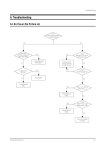
![HM-162B取扱説明書[基本編] 付属品について 登録商標](http://vs1.manualzilla.com/store/data/006692126_4-8104a1d58e277851bec4f10997046f3f-150x150.png)
